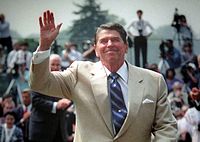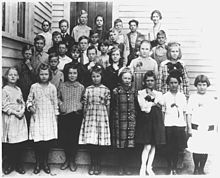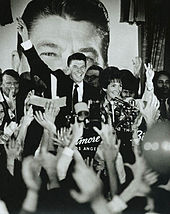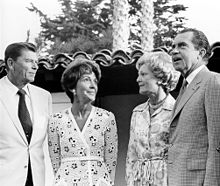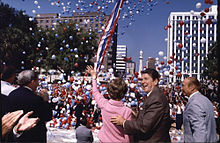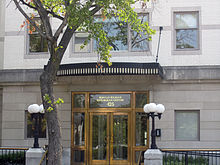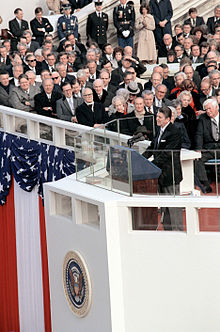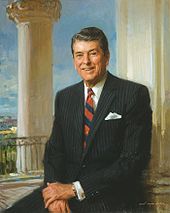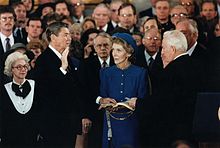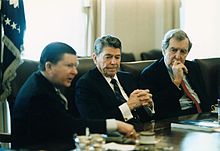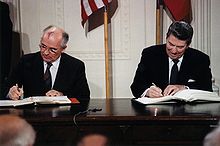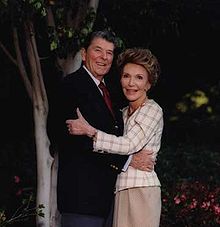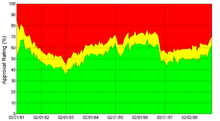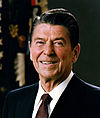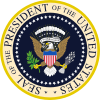- Ronald Reagan
-
"Reagan" redirects here. For other uses, see Reagan (disambiguation).
Ronald Reagan 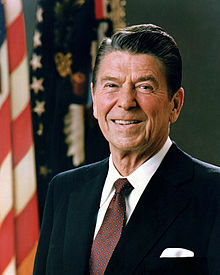
40th President of the United States In office
January 20, 1981 – January 20, 1989Vice President George H. W. Bush Preceded by Jimmy Carter Succeeded by George H. W. Bush 33rd Governor of California In office
January 2, 1967 – January 6, 1975Lieutenant Robert Finch
Edwin Reinecke
John HarmerPreceded by Pat Brown Succeeded by Jerry Brown Personal details Born February 6, 1911
Tampico, Illinois, U.S.Died June 5, 2004 (aged 93)
Los Angeles, California, U.S.Political party Republican Party (1962–2004) Other political
affiliationsDemocratic Party (Before 1962) Spouse(s) Jane Mayfield Wyman (1940-48)
Nancy Davis (1952–2004)Children Maureen
Christine
Michael
Patti
RonAlma mater Eureka College Profession Actor Religion Disciples of Christ (Formerly) Signature 
Military service Service/branch United States Army
United States Army Air ForcesYears of service 1937–45 Rank Captain Ronald Wilson Reagan (/ˈreɪɡən/; February 6, 1911 – June 5, 2004) was the 40th President of the United States (1981–1989), the 33rd Governor of California (1967–1975) and, prior to that, a radio, film and television actor.
Reagan was born in Tampico in Whiteside County, Illinois, reared in Dixon in Lee County, Illinois, and educated at Eureka College in Eureka, Illinois, with a Bachelor of Arts degree in economics and sociology. Upon his graduation, Reagan first moved to Iowa to work as a radio broadcaster and then in 1937 to Los Angeles, California. He began a career as an actor, first in films and later television, appearing in over 50 movie productions and earning enough success to become a famous, publicly recognized figure. Some of his most notable roles are in Knute Rockne, All American, Kings Row, and Bedtime for Bonzo. Reagan served as president of the Screen Actors Guild, and later spokesman for General Electric; his start in politics occurred during his work for GE. Originally a member of the Democratic Party, he began to support Republican Party candidates in the early 1950s and eventually switched to the Republican Party in 1962. After delivering a rousing speech in support of Barry Goldwater's presidential candidacy in 1964, he was persuaded to seek the California governorship, winning two years later and again in 1970. He was defeated in his run for the Republican presidential nomination in 1968 as well as 1976, but won both the nomination and election in 1980, defeating incumbent Jimmy Carter.
As president, Reagan implemented sweeping new political and economic initiatives. His supply-side economic policies, dubbed "Reaganomics", advocated reducing tax rates to spur economic growth, controlling the money supply to reduce inflation, deregulation of the economy, and reducing government spending. In his first term he survived an assassination attempt, took a hard line against labor unions, and ordered an invasion of Grenada. He was reelected in a landslide in 1984, proclaiming that it was "Morning in America". His second term was primarily marked by foreign matters, such as the ending of the Cold War, the 1986 bombing of Libya, and the revelation of the Iran-Contra affair. Publicly describing the Soviet Union as an "evil empire",[1] he supported anti-communist movements worldwide and spent his first term forgoing the strategy of détente by ordering a massive military buildup in an arms race with the USSR. Reagan negotiated with General Secretary of the Communist Party of the Soviet Union Mikhail Gorbachev, culminating in the INF Treaty and the decrease of both countries' nuclear arsenals.
Reagan left office in 1989. In 1994, the former president disclosed that he had been diagnosed with Alzheimer's disease earlier in the year; he died ten years later at the age of 93. He ranks highly in public opinion polls of U.S. Presidents and is credited for generating an ideological renaissance on the American political right.
Early life
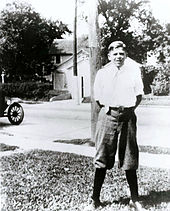 Ronald Reagan as a teenager in Dixon, Illinois
Ronald Reagan as a teenager in Dixon, Illinois
Ronald Wilson Reagan was born in an apartment on the second floor of a commercial building in Tampico, Illinois on February 6, 1911, to Jack Reagan and Nelle Wilson Reagan.[2] Reagan's father was a salesman and a storyteller, the grandson of Irish Catholic immigrants from County Tipperary[3] while his mother had Scots-English ancestors.[4] Reagan had one older brother, Neil "Moon" Reagan (1908–1996), who became an advertising executive.[5] As a boy, Reagan's father nicknamed his son "Dutch", due to his "fat little Dutchman"-like appearance, and his "Dutchboy" haircut;[6] the nickname stuck with him throughout his youth.[6] Reagan's family briefly lived in several towns and cities in Illinois, including Monmouth, Galesburg and Chicago, until 1919, when they returned to Tampico and lived above the H.C. Pitney Variety Store.[2] After his election as president, residing in the upstairs White House private quarters, Reagan would quip that he was "living above the store again".[7]
According to Paul Kengor, author of God and Ronald Reagan, Reagan had a particularly strong faith in the goodness of people, which stemmed from the optimistic faith of his mother, Nelle,[8] and the Disciples of Christ faith,[8] which he was baptized into in 1922.[9] For the time, Reagan was unusual in his opposition to racial discrimination, and recalled a time in Dixon when the local inn would not allow black people to stay there. Reagan brought them back to his house, where his mother invited them to stay the night and have breakfast the next morning.[10]
Following the closure of the Pitney Store in late 1920, the Reagans moved to Dixon;[11] the midwestern "small universe" had a lasting impression on Reagan.[12] He attended Dixon High School,[13] where he developed interests in acting, sports, and storytelling.[14] His first job was as a lifeguard at the Rock River in Lowell Park, near Dixon, in 1927. Reagan performed 77 rescues as a lifeguard, noting that he notched a mark on a wooden log for every life he saved.[14] Reagan attended Eureka College, where he became a member of the Tau Kappa Epsilon fraternity, and majored in economics and sociology. He developed a reputation as a jack of all trades, excelling in campus politics, sports and theater. He was a member of the football team, captain of the swim team and was elected student body president. As student president, Reagan notably led a student revolt against the college president after he tried to cut back the faculty.[15]
Military service
After completing fourteen home-study Army Extension Courses, Reagan enlisted in the Army Enlisted Reserve[16] on April 29, 1937, as a private assigned to Troop B, 322nd Cavalry at Des Moines, Iowa.[17] He was commissioned a Second Lieutenant in the Officers Reserve Corps of the Cavalry on May 25, 1937.[18]
Reagan was ordered to active duty for the first time on April 18, 1942. Due to his nearsightedness, he was classified for limited service only, which excluded him from serving overseas.[19] His first assignment was at the San Francisco Port of Embarkation at Fort Mason, California, as a liaison officer of the Port and Transportation Office.[20] Upon the approval of the Army Air Force (AAF), he applied for a transfer from the Cavalry to the AAF on May 15, 1942, and was assigned to AAF Public Relations and subsequently to the First Motion Picture Unit (officially, the "18th AAF Base Unit") in Culver City, California.[20] On January 14, 1943 he was promoted to First Lieutenant and was sent to the Provisional Task Force Show Unit of This Is The Army at Burbank, California.[20] He returned to the First Motion Picture Unit after completing this duty and was promoted to Captain on July 22, 1943.[17]
In January 1944, Captain Reagan was ordered to temporary duty in New York City to participate in the opening of the sixth War Loan Drive. He was re-assigned to the First Motion Picture Unit on November 14, 1944, where he remained until the end of World War II.[17] He was recommended for promotion to Major on February 2, 1945, but this recommendation was disapproved on July 17 of that year.[21] He returned to Fort MacArthur, California, where he was separated from active duty on December 9, 1945.[21] By the end of the war, his units had produced some 400 training films for the AAF.[17]
Entertainment career
Further information: Ronald Reagan filmographyRadio and film
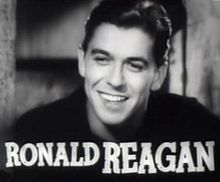 Reagan starred in Cowboy from Brooklyn in 1938.
Reagan starred in Cowboy from Brooklyn in 1938.
After graduating from Eureka in 1932, Reagan drove himself to Iowa, where he auditioned for a job at many small-town radio stations.[22] The University of Iowa hired him to broadcast home football games for the Hawkeyes. He was paid $10 per game.[22] Soon after, a staff announcer's job opened at radio station WOC in Davenport, and Reagan was hired, now earning $100 per month.[22] Aided by his persuasive voice,[22] he moved to WHO radio in Des Moines as an announcer for Chicago Cubs baseball games.[23] His specialty was creating play-by-play accounts of games that the station received by wire.[22]
While traveling with the Cubs in California, Reagan took a screen test in 1937 that led to a seven-year contract with Warner Brothers studios.[24] He spent the first few years of his Hollywood career in the "B film" unit, where, Reagan joked, the producers "didn't want them good, they wanted them Thursday".[22] While sometimes overshadowed by other actors, Reagan's screen performances did receive many good reviews.[22]
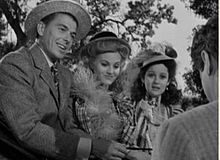 Reagan in Kings Row, which gave a brief boost to his career, in 1942
Reagan in Kings Row, which gave a brief boost to his career, in 1942
His first screen credit was the starring role in the 1937 movie Love Is on the Air, and by the end of 1939 he had already appeared in 19 films,[25] including Dark Victory. Before the film Santa Fe Trail in 1940, he played the role of George "The Gipper" Gipp in the film Knute Rockne, All American; from it, he acquired the lifelong nickname "the Gipper".[26] Reagan's favorite acting role was as a double amputee in 1942's Kings Row,[27] in which he recites the line, "Where's the rest of me?", later used as the title of his 1965 autobiography. Many film critics considered Kings Row to be his best movie,[28] though the film was condemned by New York Times critic Bosley Crowther.[29][30]
 Bedtime for Bonzo poster (1951)
Bedtime for Bonzo poster (1951)
Reagan called Kings Row the film that "made me a star".[31] However, he was unable to capitalize on his success because he was ordered to active duty with the U.S. Army at San Francisco two months after its release, and never regained "star" status in motion pictures.[31] In the post-war era, after being separated from almost four years of World War II stateside service with the 1st Motion Picture Unit in December 1945, Reagan co-starred in such films as, The Voice of the Turtle, John Loves Mary, The Hasty Heart, Bedtime for Bonzo, Cattle Queen of Montana, Tennessee's Partner, Hellcats of the Navy and The Killers (his final film) in a 1964 remake.[32]
Fan mail
While he worked at Warner Bros.,[33] Reagan enlisted his mother Nelle Wilson Reagan to answer his fan mail. She would hand-write letters and sign his name as if he had written the letters himself. Mrs. Reagan would sign her actor-son's name on photographs and even on membership cards in the Ronald Reagan Fan Club.[34] The article "Devoted Mother, Devoted Son" in the January/February 1985 issue of The Pen & Quill, journal of the Universal Autograph Collectors Club, compares the handwriting of mother and son, pointing out the differences, and also reveals that Reagan was paying his mother $75.00 a week.[35]
SAG president and television
 Television star Ronald Reagan as the host of General Electric Theater
Television star Ronald Reagan as the host of General Electric Theater
Reagan was first elected to the Board of Directors of the Screen Actors Guild in 1941, serving as an alternate. Following World War II, he resumed service and became 3rd vice-president in 1946.[36] The adoption of conflict-of-interest bylaws in 1947 led the SAG president and six board members to resign; Reagan was nominated in a special election for the position of president and subsequently elected.[36] He would subsequently be chosen by the membership to seven additional one-year terms, from 1947 to 1952 and in 1959.[36] Reagan led SAG through eventful years that were marked by labor-management disputes, the Taft-Hartley Act, House Committee on Un-American Activities (HUAC) hearings and the Hollywood blacklist era.[36]
Amid the Red Scare in the late 1940s, Reagan provided the FBI with names of actors whom he believed to be communist sympathizers within the motion picture industry.[37] Reagan testified before the House Un-American Activities Committee on the subject as well.[38] A fervent anti-communist, he reaffirmed his commitment to democratic principles, stating, "I never as a citizen want to see our country become urged, by either fear or resentment of this group, that we ever compromise with any of our democratic principles through that fear or resentment."[38]
Though an early critic of television, Reagan landed fewer film roles in the late 1950s and decided to join the medium.[22] He was hired as the host of General Electric Theater, a series of weekly dramas that became very popular.[22] His contract required him to tour GE plants sixteen weeks out of the year, often demanding of him fourteen speeches per day.[22] He earned approximately $125,000 per year (about $1.07 million in 2010 dollars) in this role. His final work as a professional actor was as host and performer from 1964 to 1965 on the television series Death Valley Days.[32] Reagan and Nancy Davis appeared together several times, including an episode of GE Theater in 1958 called A Turkey for the President.[39]
Marriages and children
In 1938, Reagan co-starred in the film Brother Rat with actress Jane Wyman (1917–2007). They were engaged at the Chicago Theatre,[40] and married on January 26, 1940, at the Wee Kirk o' the Heather church in Glendale, California.[41] Together they had two children, Maureen (1941–2001) and Christine (June 26, 1947 – June 27, 1947), and adopted a third, Michael (born 1945).[42] Following arguments about Reagan's political ambitions, Wyman filed for divorce in 1948,[43] citing a distraction due to her husband's Screen Actors Guild union duties; the divorce was finalized in 1949.[26] He is the only US president to have been divorced.[44]
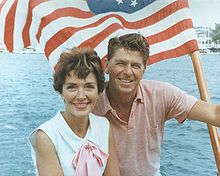 Ronald and Nancy Reagan aboard a boat in California in 1964
Ronald and Nancy Reagan aboard a boat in California in 1964
Reagan met actress Nancy Davis (born 1921)[45] in 1949 after she contacted him in his capacity as president of the Screen Actors Guild to help her with issues regarding her name appearing on a communist blacklist in Hollywood (she had been mistaken for another Nancy Davis). She described their meeting by saying, "I don't know if it was exactly love at first sight, but it was pretty close."[46] They were engaged at Chasen's restaurant in Los Angeles and were married on March 4, 1952, at the Little Brown Church in the San Fernando Valley.[47] Actor William Holden served as best man at the ceremony. They had two children: Patti (born October 21, 1952) and Ron (born May 20, 1958).
Observers described the Reagans' relationship as close, real and intimate.[48] During his presidency they were reported as frequently displaying their affection for one another; one press secretary said, "They never took each other for granted. They never stopped courting."[46][49] He often called her "Mommy" she called him "Ronnie".[49] He once wrote to her, "Whatever I treasure and enjoy ... all would be without meaning if I didn’t have you."[50] When he was in the hospital in 1981, she slept with one of his shirts to be comforted by his scent.[51] In a letter to U.S. citizens written in 1994, Reagan wrote "I have recently been told that I am one of the millions of Americans who will be afflicted with Alzheimer's disease.... I only wish there was some way I could spare Nancy from this painful experience,"[46] and in 1998, while Reagan was stricken by Alzheimer's, Nancy told Vanity Fair, "Our relationship is very special. We were very much in love and still are. When I say my life began with Ronnie, well, it's true. It did. I can't imagine life without him."[46]
Early political career
Reagan began his political career as a liberal Democrat, admirer of Franklin D. Roosevelt, and an active supporter of New Deal policies. In the early 1950s, as his relationship with Republican actress Nancy Davis grew,[52][53] he shifted to the right and, while remaining a Democrat, endorsed the presidential candidacies of Dwight D. Eisenhower in 1952 and 1956 as well as Richard Nixon in 1960.[54] The last time Reagan actively supported a Democratic candidate was in 1950 when he helped Helen Gahagan Douglas in her unsuccessful Senate campaign against Richard Nixon.[55] After being hired in 1954 to host the General Electric Theater, a TV drama series,[56] Reagan soon began to embrace the conservative views of the sponsoring company's officials.[56][57] His many GE speeches—which he wrote himself—were non-partisan but carried a conservative, pro-business message; he was influenced by Lemuel Boulware, a senior GE executive. Boulware, known for his tough stance against unions and his innovative strategies to win over workers, championed the core tenets of modern American conservatism: free markets, anticommunism, lower taxes, and limited government.[58] Eventually, the ratings for Reagan's show fell off and GE dropped Reagan in 1962.[59] In August of that year Reagan formally switched to the Republican Party, stating, "I didn't leave the Democratic Party. The party left me."[60]
Reagan opposed certain civil rights legislation, saying "If an individual wants to discriminate against Negroes or others in selling or renting his house, it is his right to do so".[61] He later reversed his opposition to voting rights and fair housing laws. He strongly denied having racist motives.[62] When legislation that would become Medicare was introduced in 1961, Reagan created a recording for the American Medical Association warning that such legislation would mean the end of freedom in America. Reagan said that if his listeners did not write letters to prevent it, "we will awake to find that we have socialism. And if you don't do this, and if I don't do it, one of these days, you and I are going to spend our sunset years telling our children, and our children's children, what it once was like in America when men were free."[63][64][65]
Reagan endorsed the campaign of conservative presidential contender Barry Goldwater in 1964. Speaking for Goldwater, Reagan stressed his belief in the importance of smaller government. He revealed his ideological motivation in a famed speech delivered on October 27, 1964: "The Founding Fathers knew a government can't control the economy without controlling people. And they knew when a government sets out to do that, it must use force and coercion to achieve its purpose. So we have come to a time for choosing."[66] This "Time for Choosing" speech raised $1 million for Goldwater's campaign[22] and is considered the event that launched Reagan's political career.[67]
Reagan was a Life Member of the National Rifle Association.[68]
Governor of California, 1967–1975
Main article: Governorship of Ronald ReaganCalifornia Republicans were impressed with Reagan's political views and charisma after his "Time for Choosing" speech,[69] and nominated him for Governor of California in 1966. In Reagan's campaign, he emphasized two main themes: "to send the welfare bums back to work," and, in reference to burgeoning anti-war and anti-establishment student protests at the University of California at Berkeley, "to clean up the mess at Berkeley."[70] He was elected, defeating two-term governor Edmund G. "Pat" Brown, and was sworn in on January 2, 1967. In his first term, he froze government hiring and approved tax hikes to balance the budget.[71]
Shortly after the beginning of his term, Reagan tested the presidential waters in 1968 as part of a "Stop Nixon" movement, hoping to cut into Nixon's Southern support[72] and be a compromise candidate[73] if neither Nixon nor second-place Nelson Rockefeller received enough delegates to win on the first ballot at the Republican convention. However, by the time of the convention Nixon had 692 delegate votes, 25 more than he needed to secure the nomination, followed by Rockefeller with Reagan in third place.[72]
Reagan was involved in high-profile conflicts with the protest movements of the era. On May 15, 1969, during the People's Park protests at UC Berkeley, Reagan sent the California Highway Patrol and other officers to quell the protests, in an incident that became known as "Bloody Thursday", resulting in the death of student James Rector and the blinding of carpenter Alan Blanchard.[74][75] Reagan then called out 2,200 state National Guard troops to occupy the city of Berkeley for two weeks in order to crack down on the protesters.[74] A year after "Bloody Thursday", Reagan responded to questions about campus protest movements saying, "If it takes a bloodbath, let's get it over with. No more appeasement."[76] When the Symbionese Liberation Army kidnapped Patty Hearst in Berkeley and demanded the distribution of food to the poor, Reagan joked, "It's just too bad we can't have an epidemic of botulism."[77]
Early in 1967, the national debate on abortion was beginning. Democratic California state senator Anthony Beilenson introduced the "Therapeutic Abortion Act," in an effort to reduce the number of "back-room abortions" performed in California.[74] The State Legislature sent the bill to Reagan's desk where, after many days of indecision, he signed it.[78] About two million abortions would be performed as a result, most because of a provision in the bill allowing abortions for the well-being of the mother.[78] Reagan had been in office for only four months when he signed the bill, and stated that had he been more experienced as governor, it would not have been signed. After he recognized what he called the "consequences" of the bill, he announced that he was pro-life.[78] He maintained that position later in his political career, writing extensively about abortion.[79]
Despite an unsuccessful attempt to recall him in 1968,[80] Reagan was re-elected in 1970, defeating "Big Daddy" Jesse Unruh. He chose not to seek a third term in the following election cycle. One of Reagan's greatest frustrations in office concerned capital punishment, which he strongly supported.[27] His efforts to enforce the state's laws in this area were thwarted when the Supreme Court of California issued its People v. Anderson decision, which invalidated all death sentences issued in California prior to 1972, though the decision was later overturned by a constitutional amendment. The only execution during Reagan's governorship was on April 12, 1967, when Aaron Mitchell's sentence was carried out by the state in San Quentin's gas chamber.[81]
In 1969, Reagan, as Governor, signed the Family Law Act which was the first no fault divorce legislation in the United States.[82]
Reagan's terms as governor helped to shape the policies he would pursue in his later political career as president. By campaigning on a platform of sending "the welfare bums back to work," he spoke out against the idea of the welfare state. He also strongly advocated the Republican ideal of less government regulation of the economy, including that of undue federal taxation.[83]
Reagan did not seek re-election to a third term as governor in 1974 and was succeeded by Democratic California Secretary of State Jerry Brown on January 6, 1975.
1976 presidential campaign
In 1976, Reagan challenged incumbent President Gerald Ford in a bid to become the Republican Party's candidate for president. Reagan soon established himself as the conservative candidate with the support of like-minded organizations such as the American Conservative Union which became key components of his political base, while President Ford was considered a more moderate Republican.[84]
Reagan's campaign relied on a strategy crafted by campaign manager John Sears of winning a few primaries early to damage the inevitability of Ford's likely nomination. Reagan won North Carolina, Texas, and California, but the strategy failed, as[85] he ended up losing New Hampshire, Florida, and his native Illinois.[86] The Texas campaign lent renewed hope to Reagan, when he swept all ninety-six delegates chosen in the May 1 primary, with four more awaiting at the state convention. Much of the credit for that victory came from the work of three co-chairmen, including Ernest Angelo, the mayor of Midland, and Ray Barnhart of Houston, whom President Reagan tapped in 1981 as director of the Federal Highway Administration.[87]
However, as the GOP convention neared, Ford appeared close to victory. Acknowledging his party's moderate wing, Reagan chose moderate Senator Richard Schweiker of Pennsylvania as his running mate if nominated. Nonetheless, Ford prevailed with 1,187 delegates to Reagan's 1,070.[86] Ford would go on to lose the 1976 Presidential election to the Democrat Jimmy Carter.
Reagan's concession speech emphasized the dangers of nuclear war and the threat posed by the Soviet Union. Though he lost the nomination, he received 307 write-in votes in New Hampshire, 388 votes as an Independent on Wyoming's ballot, and a single electoral vote from a faithless elector in the November election from the state of Washington,[88] which Ford had won over Democratic challenger Jimmy Carter.
1980 presidential campaign
Main articles: Ronald Reagan presidential campaign, 1980 and United States presidential election, 1980The Republican National Committee's Ronald Reagan Center is located near Union Station in Washington, D.C..
The 1980 presidential campaign between Reagan and incumbent President Jimmy Carter was conducted during domestic concerns and the ongoing Iran hostage crisis. His campaign stressed some of his fundamental principles: lower taxes to stimulate the economy,[89] less government interference in people's lives,[90] states' rights,[91] a strong national defense,[90] and restoring the U.S. Dollar to a gold standard.[92][93]
Reagan launched his campaign by declaring "I believe in states' rights," in Philadelphia, Mississippi, known at the time for the murder of three civil rights workers who had been trying to register African-Americans to vote during the civil rights movement.[94][95][96] After receiving the Republican nomination, Reagan selected one of his primary opponents, George H.W. Bush, to be his running mate. His showing in the October televised debate boosted his campaign. Reagan won the election, carrying 44 states with 489 electoral votes to 49 electoral votes for Carter (representing six states and Washington, D.C.). Reagan received 50.7% of the popular vote while Carter took 41%, and Independent John B. Anderson (a liberal Republican) received 6.7%.[97] Republicans captured the Senate for the first time since 1952, and gained 34 House seats, but the Democrats retained a majority.
During the presidential campaign, questions were raised by reporters on Reagan's stance on the Briggs Initiative, also known as Proposition 6, a ballot initiative in Reagan's home state of California where he was governor, which would have banned gays, lesbians, and supporters of LGBT rights from working in public schools in California. His opposition to the initiative was instrumental in its landslide defeat by Californian voters. Reagan published an editorial in which he stated "homosexuality is not a contagious disease like the measles..." and that prevailing scientific opinion was that a child's sexual orientation cannot be influenced by someone else.[98]
Presidency, 1981–1989
Main articles: Electoral history of Ronald Reagan, Domestic policy of the Ronald Reagan administration, Foreign policy of the Ronald Reagan administration, Presidency of Ronald Reagan, and Reagan DoctrineDuring his Presidency, Reagan pursued policies that reflected his personal belief in individual freedom, brought changes domestically, both to the U.S. economy and expanded military, and contributed to the end of the Cold War.[99] Termed the Reagan Revolution, his presidency would reinvigorate American morale[100][101] and reduce the people's reliance upon government.[99] As president, Reagan kept a series of diaries in which he commented on daily occurrences of his presidency and his views on the issues of the day. The diaries were published in May 2007 in the bestselling book, The Reagan Diaries.[102]
First term, 1981–1985
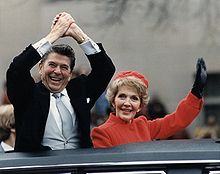 The Reagans wave from the limousine taking them down Pennsylvania Avenue to the White House, right after the president's inauguration
The Reagans wave from the limousine taking them down Pennsylvania Avenue to the White House, right after the president's inauguration
To date, Reagan is the oldest man elected to the office of the presidency (at 69).[103] In his first inaugural address on January 20, 1981, which Reagan himself wrote,[104] he addressed the country's economic malaise arguing: "In this present crisis, government is not the solution to our problems; government is the problem."
The Reagan Presidency began in a dramatic manner; as Reagan was giving his inaugural address, 52 U.S. hostages, held by Iran for 444 days were set free.[105]
Assassination attempt
Main article: Reagan assassination attemptOn March 30, 1981, only 69 days into the new administration, Reagan, his press secretary James Brady, Washington police officer Thomas Delahanty, and Secret Service agent Timothy McCarthy were struck by gunfire from would-be assassin John Hinckley, Jr. outside the Washington Hilton Hotel. Although "close to death" during surgery,[106] Reagan recovered and was released from the hospital on April 11, becoming the first serving U.S. President to survive being shot in an assassination attempt.[107] The attempt had great influence on Reagan's popularity; polls indicated his approval rating to be around 73%.[108] Reagan believed that God had spared his life so that he might go on to fulfill a greater purpose.[109]
Establishing full U.S. diplomatic relations with the Vatican
Within months of President Reagan’s inaugural in 1981, one of the first steps taken by Reagan was to obtain the repeal of the 1868 federal law which prohibited the expenditure of funds for a U.S. Embassy to the Vatican. Reagan was successful in obtaining the repeal without real opposition.
President Reagan announced on January 10, 1984 that full diplomatic relations between the United States and the Vatican had been established. The President did this over the opposition of the office of the Secretary of State.[110]
Air traffic controllers' strike
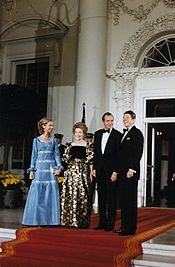 Ronald Reagan and Nancy Reagan greet King Juan Carlos I of Spain and his wife Queen Sofía, in October, 1981
Ronald Reagan and Nancy Reagan greet King Juan Carlos I of Spain and his wife Queen Sofía, in October, 1981 Main article: Professional Air Traffic Controllers Organization (1968)
Main article: Professional Air Traffic Controllers Organization (1968)In summer 1981 PATCO, the union of federal air traffic controllers went on strike, violating a federal law prohibiting government unions from striking.[111] Declaring the situation an emergency as described in the 1947 Taft Hartley Act, Reagan stated that if the air traffic controllers "do not report for work within 48 hours, they have forfeited their jobs and will be terminated."[112] They did not return and on August 5, Reagan fired 11,345 striking air traffic controllers who had ignored his order, and used supervisors and military controllers to handle the nation's commercial air traffic until new controllers could be hired and trained.[113] As a leading reference work on public administration concluded, "The firing of PATCO employees not only demonstrated a clear resolve by the president to take control of the bureaucracy, but it also sent a clear message to the private sector that unions no longer needed to be feared."[114]
"Reaganomics" and the economy
Main article: ReaganomicsDuring Jimmy Carter's last year in office (1980), inflation averaged 12.5%, compared to 4.4% during Reagan's last year in office (1988).[115] During Reagan's administration, the unemployment rate declined from 7.1% to 5.5%, with the average annual rate hitting highs of 9.7% in 1982 and 9.6% in 1983, averaging 7.5% over the eight years.[116]
Reagan implemented policies based on supply-side economics and advocated a classical liberal and laissez-faire philosophy,[117] seeking to stimulate the economy with large, across-the-board tax cuts.[118][119] He also supported returning the U.S. to some sort of gold standard, and successfully urged Congress to establish the U.S. Gold Commission to study how one could be implemented. Citing the economic theories of Arthur Laffer, Reagan promoted the proposed tax cuts as potentially stimulating the economy enough to expand the tax base, offsetting the revenue loss due to reduced rates of taxation, a theory that entered political discussion as the Laffer curve. Reaganomics was the subject of debate with supporters pointing to improvements in certain key economic indicators as evidence of success, and critics pointing to large increases in federal budget deficits and the national debt. His policy of "peace through strength" (also described as "firm but fair") resulted in a record peacetime defense buildup including a 40% real increase in defense spending between 1981 and 1985.[120]
During Reagan's presidency, federal income tax rates were lowered significantly with the signing of the bipartisan Economic Recovery Tax Act of 1981[121] which lowered the top marginal tax bracket from 70% to 50% and the lowest bracket from 14% to 11%, however other tax increases signed by Reagan ensured that tax revenues over his two terms were 18.2% of GDP as compared to 18.1% over the past 40 years.[122] Then, in 1982 the Job Training Partnership Act of 1982 was signed into law, initiating one of the nation's first public/private partnerships and a major part of the president's job creation program. Reagan's Assistant Secretary of Labor and Chief of Staff, Al Angrisani, was a primary architect of the bill. The Tax Reform Act of 1986, another bipartisan effort championed by Reagan, reduced the top rate further to 28% while raising the bottom bracket from 11% to 15% and reducing the quantity of brackets to 4. Conversely, Congress passed and Reagan signed into law tax increases of some nature in every year from 1981 to 1987 to continue funding such government programs as TEFRA, Social Security, and the Deficit Reduction Act of 1984.[123][124] Despite the fact that TEFRA was the "largest peacetime tax increase in American history," Reagan is better known for his tax cuts and lower-taxes philosophy.[124][125][126][127] Real gross domestic product (GDP) growth recovered strongly after the early 1980s recession ended in 1982, and grew during his eight years in office at an annual rate of 3.85% per year.[128] Unemployment peaked at 10.8% monthly rate in December 1982—higher than any time since the Great Depression—then dropped during the rest of Reagan's presidency.[129] Sixteen million new jobs were created, while inflation significantly decreased.[130] The net effect of all Reagan-era tax bills was a 1% decrease in government revenues when compared to Treasury Department revenue estimates from the Administration's first post-enactment January budgets.[131] However, federal Income Tax receipts increased from 1980 to 1989, rising from $308.7Bn to $549.0Bn.[132]
During the Reagan Administration, federal receipts grew at an average rate of 8.2% (2.5% attributed to higher Social Security receipts), and federal outlays grew at an annual rate of 7.1%.[133][134] Reagan also revised the tax code with the bipartisan Tax Reform Act of 1986.[135]
Reagan's policies proposed that economic growth would occur when marginal tax rates were low enough to spur investment,[136] which would then lead to increased economic growth, higher employment and wages. Critics labeled this "trickle-down economics"—the belief that tax policies that benefit the wealthy will create a "trickle-down" effect to the poor.[137] Questions arose whether Reagan's policies benefited the wealthy more than those living in poverty,[138] and many poor and minority citizens viewed Reagan as indifferent to their struggles.[138] These views were exacerbated by the fact that Reagan's economic regimen included freezing the minimum wage at $3.35 an hour, slashing federal assistance to local governments by 60 percent, cutting the budget for public housing and Section 8 rent subsidies in half, and eliminating the antipoverty Community Development Block Grant program.[139]
Further following his less-government intervention views, Reagan cut the budgets of non-military[140] programs[141] including Medicaid, food stamps, federal education programs[140] and the EPA.[142] While he protected entitlement programs, such as Social Security and Medicare,[143] his administration attempted to purge many people with disabilities from the Social Security disability rolls.[144]
The administration's stance toward the Savings and Loan industry contributed to the Savings and loan crisis.[145] It is also suggested, by a minority of Reaganomics critics, that the policies partially influenced the stock market crash of 1987,[146] but there is no consensus regarding a single source for the crash.[147] In order to cover newly spawned federal budget deficits, the United States borrowed heavily both domestically and abroad, raising the national debt from $997 billion to $2.85 trillion.[148] Reagan described the new debt as the "greatest disappointment" of his presidency.[130]
He reappointed Paul Volcker as Chairman of the Federal Reserve, and in 1987 he appointed monetarist Alan Greenspan to succeed him. Reagan ended the price controls on domestic oil which had contributed to energy crises in the early 1970s.[149][150] The price of oil subsequently dropped, and the 1980s did not see the fuel shortages that the 1970s had.[151] Reagan also fulfilled a 1980 campaign promise to repeal the Windfall profit tax in 1988, which had previously increased dependence on foreign oil.[152] Some economists, such as Nobel Prize winners Milton Friedman and Robert A. Mundell, argue that Reagan's tax policies invigorated America's economy and contributed to the economic boom of the 1990s.[153] Other economists, such as Nobel Prize winner Robert Solow, argue that the deficits were a major reason why Reagan's successor, George H. W. Bush, reneged on a campaign promise and raised taxes.[153]
During Reagan's presidency, a program was initiated within the US intelligence community to ensure America's economic strength. The program, Project Socrates, developed and demonstrated the means required for the US to generate and lead the next evolutionary leap in technology acquisition and utilization for a competitive advantage—automated innovation. To ensure that the US acquired the maximum benefit from automated innovation, President Reagan, during his second term, had an executive order drafted to create a new Federal agency to implement the Project Socrates results on a nation-wide basis. However, President Reagan's term came to end before the executive order could be coordinated and signed, and the incoming Bush administration, labeling Project Socrates as "industrial policy", had it terminated.[154][155]
Lebanon and Operation Urgent Fury (Grenada), 1983
Main articles: Beirut barracks bombing and Invasion of Grenada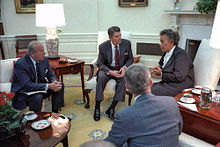 Reagan meets with Prime Minister Eugenia Charles of Dominica in the Oval Office about ongoing events in Grenada
Reagan meets with Prime Minister Eugenia Charles of Dominica in the Oval Office about ongoing events in Grenada President Ronald Reagan's keynote speech to the Rev. Jerry Fallwell's "Baptist Fundamentalism '84" convention: the Marines and their Chaplains at the 1983 Beirut barracks bombing
President Ronald Reagan's keynote speech to the Rev. Jerry Fallwell's "Baptist Fundamentalism '84" convention: the Marines and their Chaplains at the 1983 Beirut barracks bombing
American peacekeeping forces in Beirut, a part of a multinational force during the Lebanese Civil War who had been earlier deployed by Reagan, were attacked on October 23, 1983. The Beirut barracks bombing resulted in the deaths of 241 American servicemen and the wounding of more than 60 others by a suicide truck bomber. Reagan sent a White House team to the site four days later, led by his Vice President, George H.W. Bush. Reagan called the attack "despicable," pledged to keep a military force in Lebanon, and planned to target the Sheik Abdullah barracks in Baalbek, Lebanon, training ground for Hezbollah fighters,[156][157] but the mission was later aborted. On February 7, 1984, President Reagan ordered the Marines to begin withdrawal from Lebanon. In April 1984, as his keynote address to the 20,000 attendees of the Rev. Jerry Falwell's "Baptist Fundamentalism '84" convention in Washington, D.C., he read a first hand account of the bombing, written by Navy Chaplain (Rabbi) Arnold Resnicoff, who had been asked to write the report by Bush and his team.[158] Osama bin Laden would later cite Reagan's withdrawal of forces as a sign of American weakness.[159]
On October 25, 1983, only two days later, Reagan ordered U.S. forces to invade Grenada, code named Operation Urgent Fury, where a 1979 coup d'état had established an independent non-aligned Marxist-Leninist government. A formal appeal from the Organization of Eastern Caribbean States (OECS) led to the intervention of U.S. forces; President Reagan also cited an allegedly regional threat posed by a Soviet-Cuban military build-up in the Caribbean and concern for the safety of several hundred American medical students at St. George's University as adequate reasons to invade. Operation Urgent Fury was the first major military operation conducted by U.S. forces since the Vietnam War, several days of fighting commenced, resulting in a U.S. victory,[160] with 19 American fatalities and 116 wounded American soldiers.[161] In mid-December, after a new government was appointed by the Governor-General, U.S. forces withdrew.[160]
Escalation of the Cold War
See also: Cold War and Cold War (1979–1985)Reagan escalated the Cold War, accelerating a reversal from the policy of détente which began in 1979 following the Soviet war in Afghanistan.[162] Reagan ordered a massive buildup of the United States Armed Forces[120] and implemented new policies towards the Soviet Union: reviving the B-1 Lancer program that had been canceled by the Carter administration, and producing the MX missile.[163] In response to Soviet deployment of the SS-20, Reagan oversaw NATO's deployment of the Pershing missile in West Germany.[164]
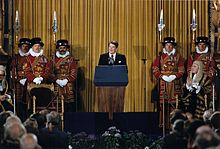 Reagan, the first American president ever to address the British Parliament, predicts Marxism-Leninism will be left on the "ash-heap of history".[165]
Reagan, the first American president ever to address the British Parliament, predicts Marxism-Leninism will be left on the "ash-heap of history".[165]
Together with the United Kingdom's prime minister Margaret Thatcher, Reagan denounced the Soviet Union in ideological terms.[166] In a famous address on June 8, 1982 to the British Parliament in the Royal Gallery of the Palace of Westminster, Reagan said, "the forward march of freedom and democracy will leave Marxism-Leninism on the ash-heap of history."[167][168] On March 3, 1983, he predicted that communism would collapse, stating, "Communism is another sad, bizarre chapter in human history whose last pages even now are being written."[169] In a speech to the National Association of Evangelicals on March 8, 1983, Reagan called the Soviet Union "an evil empire".[170]
After Soviet fighters downed Korean Air Lines Flight 007 near Moneron Island on September 1, 1983, carrying 269 people, including Georgia congressman Larry McDonald, Reagan labeled the act a "massacre" and declared that the Soviets had turned "against the world and the moral precepts which guide human relations among people everywhere".[171] The Reagan administration responded to the incident by suspending all Soviet passenger air service to the United States, and dropped several agreements being negotiated with the Soviets, wounding them financially.[171] As result of the shootdown, and the cause of KAL 007's going astray thought to be inadequacies related to its navigational system, Reagan announced on September 16, 1983 that the Global Positioning System would be made available for civilian use, free of charge, once completed in order to avert similar navigational errors in future.[172][173]
Under a policy that came to be known as the Reagan Doctrine, Reagan and his administration also provided overt and covert aid to anti-communist resistance movements in an effort to "rollback" Soviet-backed communist governments in Africa, Asia, and Latin America.[174] Reagan deployed the CIA's Special Activities Division to Afghanistan and Pakistan. They were instrumental in training, equipping and leading Mujaheddin forces against the Soviet Army.[175][176] President Reagan's Covert Action program has been given credit for assisting in ending the Soviet occupation of Afghanistan,[177] though the US funded armaments introduced then would later pose a threat to US troops in the 2000s war in Afghanistan.[178] However, in a break from the Carter policy of arming Taiwan under the Taiwan Relations Act. Reagan also agreed with the communist government in China to reduce the sale of arms to Taiwan.[179]
In March 1983, Reagan introduced the Strategic Defense Initiative, a defense project[180] that would have used ground and space-based systems to protect the United States from attack by strategic nuclear ballistic missiles.[181] Reagan believed that this defense shield could make nuclear war impossible,[180][182] but disbelief that the technology could ever work led opponents to dub SDI "Star Wars" and argue that the technological objective was unattainable.[180] The Soviets became concerned about the possible effects SDI would have;[183] leader Yuri Andropov said it would put "the entire world in jeopardy".[184] For those reasons, David Gergen, former aide to President Reagan, believes that in retrospect, SDI hastened the end of the Cold War.[185]
Critics labeled Reagan's foreign policies as aggressive, imperialistic, and chided them as "warmongering," though they were supported by leading American conservatives who argued that they were necessary to protect U.S. security interests.[183] A reformer, Mikhail Gorbachev, would later rise to power in the Soviet Union in 1985, implementing new policies for openness and reform that were called glasnost and perestroika.
1984 presidential campaign
Main article: United States presidential election, 1984 1984 presidential electoral votes by state. Reagan (red) won every state except for Mondale's home state of Minnesota (and Washington, D.C.)
1984 presidential electoral votes by state. Reagan (red) won every state except for Mondale's home state of Minnesota (and Washington, D.C.)
Reagan accepted the Republican nomination in Dallas, Texas, on a wave of positive feeling. He proclaimed that it was "morning again in America,"[22] regarding the recovering economy and the dominating performance by the U.S. athletes at the 1984 Summer Olympics, among other things. He became the first American president to open an Olympic Games held in the United States.[186]
Reagan's opponent in the 1984 presidential election was former Vice President Walter Mondale. With questions about Reagan's age, and a weak performance in the first presidential debate, his ability to perform the duties of president for another term was questioned. His apparent confused and forgetful behavior was evident to his supporters; they had previously known him clever and witty. Rumors began to circulate that he had Alzheimer's disease.[187][188] Reagan rebounded in the second debate, and confronted questions about his age, quipping, "I will not make age an issue of this campaign. I am not going to exploit, for political purposes, my opponent's youth and inexperience," which generated applause and laughter, even from Mondale himself.[189]
That November, Reagan was re-elected, winning 49 of 50 states.[190] The president's overwhelming victory saw Mondale carry only his home state of Minnesota (by 3800 votes) and the District of Columbia. Reagan won a record 525 electoral votes, the most of any candidate in United States history,[191] and received 58.8% of the popular vote to Mondale's 40.6%.[190]
Second term, 1985–1989
Reagan was sworn in as president for the second time on January 20, 1985, in a private ceremony at the White House. Because January 20 fell on a Sunday, a public celebration was not held but took place in the Capitol Rotunda the following day. January 21 was one of the coldest days on record in Washington, D.C.; due to poor weather, inaugural celebrations were held inside the Capitol.
In the summer of 1982, several conservative activists, including Howard Phillips of The Conservative Caucus and Clymer Wright of Houston, Texas, had urged Reagan to remove his White House chief of staff James Baker, also of Houston, on grounds that Baker, a political intimate of George H. W. Bush, was undercutting conservative initiatives in the administration. Not only did Reagan reject the Wright-Phillips request, but in 1985, after his reelection, he named Baker as United States Secretary of the Treasury, at Baker's request in a job-swap with then Secretary Donald T. Regan, a former Merrill Lynch officer who became chief of staff. Reagan also rebuked Wright and Phillips for having waged a "campaign of sabotage" against Baker.[192]
In 1985, Reagan visited a German military cemetery in Bitburg to lay a wreath with West German Chancellor Helmut Kohl. It was determined that the cemetery held the graves of forty-nine members of the Waffen-SS. Reagan issued a statement that called the Nazi soldiers buried in that cemetery as themselves "victims," a designation which ignited a stir over whether Reagan had equated the SS men to victims of the Holocaust; Patrick J. Buchanan, Reagan's Director of Communications, argued that the president did not equate the SS members with the actual Holocaust.[193] Now strongly urged to cancel the visit,[194] the president responded that it would be wrong to back down on a promise he had made to Chancellor Kohl. He ultimately attended the ceremony where two military generals laid a wreath.[195]
The disintegration of the Space Shuttle Challenger on January 28, 1986 proved a pivotal moment in Reagan's presidency. All seven astronauts aboard were killed.[196] On the night of the disaster, Reagan delivered a speech written by Peggy Noonan in which he said (quoting the first and last lines of John Gillespie Magee's 1941 poem High Flight):
The future doesn't belong to the fainthearted; it belongs to the brave... We will never forget them, nor the last time we saw them, this morning, as they prepared for their journey and waved goodbye and 'slipped the surly bonds of Earth' to 'touch the face of God.'[197]War on Drugs
Main article: War on DrugsMidway into his second term, Reagan declared more militant policies in the War on Drugs. He said that "drugs were menacing our society" and promised to fight for drug-free schools and workplaces, expanded drug treatment, stronger law enforcement and drug interdiction efforts, and greater public awareness.[198][199]
In 1986, Reagan signed a drug enforcement bill that budgeted $1.7 billion to fund the War on Drugs and specified a mandatory minimum penalty for drug offenses.[200] The bill was criticized for promoting significant racial disparities in the prison population[200] and critics also charged that the policies did little to reduce the availability of drugs on the street, while resulting in a great financial burden for America.[201] Defenders of the effort point to success in reducing rates of adolescent drug use.[202][203] First Lady Nancy Reagan made the War on Drugs her main priority by founding the "Just Say No" drug awareness campaign, which aimed to discourage children and teenagers from engaging in recreational drug use by offering various ways of saying "no". Mrs. Reagan traveled to 65 cities in 33 states, raising awareness about the dangers of drugs including alcohol.[204]
Libya bombing
Main article: 1986 Bombing of LibyaRelations between Libya and the U.S. under President Reagan were continually contentious, beginning with the Gulf of Sidra incident in 1981; by 1982, Gaddafi was considered by the CIA to be, along with USSR leader Leonid Brezhnev and Cuban leader Fidel Castro,[205] part of a group known as the "unholy trinity"[205] and was also labeled as "our international public enemy number one" by a CIA official.[205] These tensions were later revived in early April 1986, when a bomb exploded in a Berlin discothèque, resulting in the injury of 63 American military personnel and death of one serviceman.[206] Stating that there was "irrefutable proof" that Libya had directed the "terrorist bombing", Reagan authorized the use of force against the country.[206] In the late evening of April 15, 1986, the U.S. launched a series of air strikes on ground targets in Libya.[206][207] The UK Prime Minister Margaret Thatcher allowed the US Air Force to use Britain's air bases to launch the attack, on the justification that the UK was supporting America's right to self-defense under Article 51 of the United Nations Charter.[207] The attack was designed to halt Libyan leader Muammar Gaddafi's "ability to export terrorism", offering him "incentives and reasons to alter his criminal behavior".[206] The president addressed the nation from the Oval Office after the attacks had commenced, stating, "When our citizens are attacked or abused anywhere in the world on the direct orders of hostile regimes, we will respond so long as I'm in this office."[207] As early as 1981, Reagan had referred to Gaddafi as "the mad dog of the Middle East"[208] and considered him to be public enemy number one.[209]
Immigration
Reagan signed the Immigration Reform and Control Act in 1986. The act made it illegal to knowingly hire or recruit illegal immigrants, required employers to attest to their employees' immigration status, and granted amnesty to approximately 3 million illegal immigrants who entered the United States prior to January 1, 1982, and had lived in the country continuously. Critics argue that the employer sanctions were without teeth and failed to stem illegal immigration.[210] Upon signing the act at a ceremony held beside the newly refurbished Statue of Liberty, Reagan said, "The legalization provisions in this act will go far to improve the lives of a class of individuals who now must hide in the shadows, without access to many of the benefits of a free and open society. Very soon many of these men and women will be able to step into the sunlight and, ultimately, if they choose, they may become Americans."[211]
Iran-Contra affair
In 1986, a scandal shook the administration stemming from the use of proceeds from covert arms sales to Iran to fund the Contras in Nicaragua, which had been specifically outlawed by an act of Congress.[212][213] The Iran-Contra affair became the largest political scandal in the United States during the 1980s.[214] The International Court of Justice, whose jurisdiction to decide the case was disputed,[215] ruled that the U.S. had violated international law in Nicaragua due to its obligations not to intervene in the affairs of other states.[216]
President Reagan professed ignorance of the plot's existence. He appointed two Republicans and one Democrat (John Tower, Brent Scowcroft and Edmund Muskie, known as the "Tower Commission") to investigate the scandal. The commission could not find direct evidence that Reagan had prior knowledge of the program, but criticized him heavily for his disengagement from managing his staff, making the diversion of funds possible.[217] A separate report by Congress concluded that "If the president did not know what his national security advisers were doing, he should have."[217] Reagan's popularity declined from 67 percent to 46 percent in less than a week, the greatest and quickest decline ever for a president.[218] The scandal resulted in fourteen indictments within Reagan's staff, and eleven convictions.[219]
Many Central Americans criticize Reagan for his support of the Contras, calling him an anti-communist zealot, blinded to human rights abuses, while others say he "saved Central America".[220] Daniel Ortega, Sandinistan and current president of Nicaragua, said that he hoped God would forgive Reagan for his "dirty war against Nicaragua".[220] In 1986 the USA was found guilty by the International Court of Justice (World Court) of war crimes against Nicaragua.[221]
End of the Cold War
See also: Cold War (1985–1991)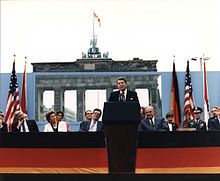 Ronald Reagan speaks at the Berlin Wall's Brandenburg Gate, challenging Gorbachev to "tear down this wall!"
Ronald Reagan speaks at the Berlin Wall's Brandenburg Gate, challenging Gorbachev to "tear down this wall!"
By the early 1980s, the USSR had built up a military arsenal and army surpassing that of the United States. Previously, the U.S. had relied on the qualitative superiority of its weapons to essentially frighten the Soviets, but the gap had been narrowed.[222] After President Reagan's military buildup, the Soviet Union did not further dramatically build up its military;[223] the enormous military expenses, in combination with collectivized agriculture and inefficient planned manufacturing, were a heavy burden for the Soviet economy.[224] At the same time, the Reagan Administration persuaded Saudi Arabia to increase oil production,[225] which resulted in a drop of oil prices in 1985 to one-third of the previous level; oil was the main source of Soviet export revenues.[224] These factors gradually brought the Soviet economy to a stagnant state during Gorbachev's tenure.[224]
Reagan recognized the change in the direction of the Soviet leadership with Mikhail Gorbachev, and shifted to diplomacy, with a view to encourage the Soviet leader to pursue substantial arms agreements.[226] Reagan's personal mission was to achieve "a world free of nuclear weapons," which he regarded as "totally irrational, totally inhumane, good for nothing but killing, possibly destructive of life on earth and civilization."[227][228][229] He was able to start discussions on nuclear disarmament with General Secretary Gorbachev.[229] Gorbachev and Reagan held four summit conferences between 1985 and 1988: the first in Geneva, Switzerland, the second in Reykjavík, Iceland, the third in Washington, D.C., and the fourth in Moscow.[230] Reagan believed that if he could persuade the Soviets to allow for more democracy and free speech, this would lead to reform and the end of Communism.[231]
Speaking at the Berlin Wall on June 12, 1987, Reagan challenged Gorbachev to go further, saying:
“ "General Secretary Gorbachev, if you seek peace, if you seek prosperity for the Soviet Union and Eastern Europe, if you seek liberalization, come here to this gate! Mr. Gorbachev, open this gate! Mr. Gorbachev, tear down this wall!" ” Prior to Gorbachev visiting Washington, D.C., for the third summit in 1987, the Soviet leader announced his intention to pursue significant arms agreements.[232] The timing of the announcement led Western diplomats to contend that Gorbachev was offering major concessions to the U.S. on the levels of conventional forces, nuclear weapons, and policy in Eastern Europe.[232] He and Reagan signed the Intermediate-Range Nuclear Forces (INF) Treaty at the White House, which eliminated an entire class of nuclear weapons.[233] The two leaders laid the framework for the Strategic Arms Reduction Treaty, or START I; Reagan insisted that the name of the treaty be changed from Strategic Arms Limitation Talks to Strategic Arms Reduction Talks.[228]
When Reagan visited Moscow for the fourth summit in 1988, he was viewed as a celebrity by the Soviets. A journalist asked the president if he still considered the Soviet Union the evil empire. "No," he replied, "I was talking about another time, another era."[234] At Gorbachev's request, Reagan gave a speech on free markets at the Moscow State University.[235] In his autobiography, An American Life, Reagan expressed his optimism about the new direction that they charted and his warm feelings for Gorbachev.[236] In November 1989, the Berlin Wall was torn down, the Cold War was officially declared over at a Malta Summit on December 3, 1989[237] and two years later, the Soviet Union collapsed.
Health
Early in his presidency, Reagan started wearing a custom, technologically advanced hearing aid, first in his right ear[238] and later in his left as well.[239] His decision to go public in 1983 regarding his wearing the small, audio-amplifying device boosted their sales.[240]
On July 13, 1985, Reagan underwent surgery at Bethesda Naval Hospital to remove cancerous polyps from his colon. He relinquished presidential power to the Vice President for eight hours in a similar procedure as outlined in the 25th Amendment, which he specifically avoided invoking.[241] The surgery lasted just under three hours and was successful.[242] Reagan resumed the powers of the presidency later that day.[243] In August of that year, he underwent an operation to remove skin cancer cells from his nose.[244] In October, additional skin cancer cells were detected on his nose and removed.[245]
In January 1987, Reagan underwent surgery for an enlarged prostate which caused further worries about his health. No cancerous growths were found, however, and he was not sedated during the operation.[246] In July of that year, aged 76, he underwent a third skin cancer operation on his nose.[247]
Judiciary
Main articles: Ronald Reagan Supreme Court candidates and Ronald Reagan judicial appointmentsDuring his 1980 campaign, Reagan pledged that, if given the opportunity, he would appoint the first female Supreme Court Justice.[248] That opportunity came in his first year in office when he nominated Sandra Day O'Connor to fill the vacancy created by the retirement of Justice Potter Stewart. In his second term, Reagan elevated William Rehnquist to succeed Warren Burger as Chief Justice, and named Antonin Scalia to fill the vacant seat. Reagan nominated conservative jurist Robert Bork to the high court in 1987. Senator Ted Kennedy, a Democrat of Massachusetts, strongly condemned Bork, and great controversy ensued.[249] Bork's nomination was rejected 58–42.[250] Reagan then nominated Douglas Ginsburg, but Ginsburg withdrew his name from consideration after coming under fire for his cannabis use.[251] Anthony Kennedy was eventually confirmed in his place.[252] Along with his three Supreme Court appointments, Reagan appointed 83 judges to the United States Courts of Appeals, and 290 judges to the United States district courts.
Reagan also nominated Vaughn R. Walker, who would later be revealed to be the earliest known gay federal judge,[253] to the United States District Court for the Central District of California. However, the nomination stalled in the Senate, and Walker was not confirmed until he was renominated by Reagan's successor, George H. W. Bush.[254]
Post-presidential years, 1989–2004
After leaving office in 1989, the Reagans purchased a home in Bel Air, Los Angeles in addition to the Reagan Ranch in Santa Barbara. They regularly attended Bel Air Presbyterian Church[255] and occasionally made appearances on behalf of the Republican Party; Reagan delivered a well-received speech at the 1992 Republican National Convention.[256] Previously on November 4, 1991, the Ronald Reagan Presidential Library was dedicated and opened to the public. At the dedication ceremonies, five presidents were in attendance, as well as six first ladies, marking the first time five presidents were gathered in the same location.[257] Reagan continued publicly to speak in favor of a line-item veto; the Brady Bill;[258] a constitutional amendment requiring a balanced budget; and the repeal of the 22nd Amendment, which prohibits anyone from serving more than two terms as president.[259] In 1992 Reagan established the Ronald Reagan Freedom Award with the newly formed Ronald Reagan Presidential Foundation.[260] His final public speech was on February 3, 1994 during a tribute to him in Washington, D.C., and his last major public appearance was at the funeral of Richard Nixon on April 27, 1994.
Alzheimer's disease
Announcement and reaction
In August 1994, at the age of 83, Reagan was diagnosed with Alzheimer's disease,[261] an incurable neurological disorder which destroys brain cells and ultimately causes death.[261][262] In November he informed the nation through a handwritten letter,[261] writing in part:
I have recently been told that I am one of the millions of Americans who will be afflicted with Alzheimer's Disease... At the moment I feel just fine. I intend to live the remainder of the years God gives me on this earth doing the things I have always done... I now begin the journey that will lead me into the sunset of my life. I know that for America there will always be a bright dawn ahead. Thank you, my friends. May God always bless you.[263]After his diagnosis, letters of support from well-wishers poured into his California home,[264] but there was also speculation over how long Reagan had demonstrated symptoms of mental degeneration.[265] In her memoirs, former CBS White House correspondent Lesley Stahl recounts her final meeting with the president, in 1986: "Reagan didn't seem to know who I was. ... Oh, my, he's gonzo, I thought. I have to go out on the lawn tonight and tell my countrymen that the president of the United States is a doddering space cadet." But then, at the end, he regained his alertness. As she described it, "I had come that close to reporting that Reagan was senile."[266] However, Dr. Lawrence K. Altman, a physician employed as a reporter for the New York Times, noted that "the line between mere forgetfulness and the beginning of Alzheimer's can be fuzzy"[267] and all four of Reagan's White House doctors said that they saw no evidence of Alzheimer's while he was president.[267] Dr. John E. Hutton, Reagan's primary physician from 1984 to 1989, said the president "absolutely" did not "show any signs of dementia or Alzheimer's".[267] Reagan did experience occasional memory lapses, though, especially with names.[267] Once, while meeting with Japanese Prime Minister Yasuhiro Nakasone, he repeatedly referred to Vice President Bush as "Prime Minister Bush".[268] Reagan's doctors, however, note that he only began exhibiting overt symptoms of the illness in late 1992[269] or 1993,[267] several years after he had left office. His former Chief of Staff James Baker considered "ludicrous" the idea of Reagan sleeping during cabinet meetings.[270] Other staff members, former aides, and friends said they saw no indication of Alzheimer's while he was President.[267] In contrast, Reagan's son, Ron Reagan, wrote in his 2011 memoir that he had noticed evidence of dementia as early as Reagan's first Presidential term, and that by 1986 Reagan was unable to recall the names of previously familiar landmarks near Los Angeles.[271]
 The Reagans with a model of USS Ronald Reagan, May 1996. With them, at left, is Newport News Shipbuilding Chairman and CEO, Bill Fricks
The Reagans with a model of USS Ronald Reagan, May 1996. With them, at left, is Newport News Shipbuilding Chairman and CEO, Bill Fricks
Complicating the picture, Reagan suffered an episode of head trauma in July 1989, five years prior to his diagnosis. After being thrown from a horse in Mexico, a subdural hematoma was found and surgically treated later in the year.[261][262] Nancy Reagan asserts that her husband's 1989 fall hastened the onset of Alzheimer's disease,[262] citing what doctors told her,[262] although acute brain injury has not been conclusively proven to accelerate Alzheimer's or dementia.[272][273] Reagan's one-time physician Dr. Daniel Ruge has said it is possible, but not certain, that the horse accident affected the course of Reagan's memory.[274]
Progression
As the years went on, the disease slowly destroyed Reagan's mental capacity.[267] He was only able to recognize a few people, including his wife, Nancy.[267] He remained active, however; he took walks through parks near his home and on beaches, played golf regularly, and until 1999 he often went to his office in nearby Century City.[267]
Reagan suffered a fall at his Bel Air home on January 13, 2001, resulting in a broken hip.[275] The fracture was repaired the following day[276] and the 89 year old Reagan returned home later that week, although he faced difficult physical therapy at home.[277] On February 6, 2001, Reagan reached the age of 90, becoming the third former president to do so (the other two being John Adams and Herbert Hoover, with Gerald Ford later reaching 90).[278] Reagan's public appearances became much less frequent with the progression of the disease, and as a result, his family decided that he would live in quiet isolation. Nancy Reagan told CNN's Larry King in 2001 that very few visitors were allowed to see her husband because she felt that "Ronnie would want people to remember him as he was."[279] Following her husband's diagnosis and death, Mrs. Reagan became a stem-cell research advocate, urging Congress and President George W. Bush to support federal funding for embryonic stem-cell research, something Bush opposed. In 2009, she praised President Barack Obama for lifting restrictions on such research.[280] Mrs. Reagan has said that she believes that it could lead to a cure for Alzheimer's.[281]
Death
Main article: Death and state funeral of Ronald Reagan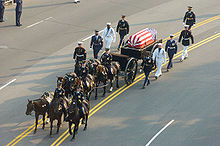 Ronald Reagan's casket, on a horse-drawn caisson, being pulled down Constitution Avenue to the Capitol
Ronald Reagan's casket, on a horse-drawn caisson, being pulled down Constitution Avenue to the Capitol
Reagan died of pneumonia[282] at his home in Bel Air, California on the afternoon of June 5, 2004.[283] A short time after his death, Nancy Reagan released a statement saying: "My family and I would like the world to know that President Ronald Reagan has died after 10 years of Alzheimer's Disease at 93 years of age. We appreciate everyone's prayers."[283] President George W. Bush declared June 11 a National Day of Mourning,[284] and international tributes came in from around the world.[285] Reagan's body was taken to the Kingsley and Gates Funeral Home in Santa Monica, California later in the day, where well-wishers paid tribute by laying flowers and American flags in the grass.[286] On June 7, his body was removed and taken to the Ronald Reagan Presidential Library, where a brief family funeral was held conducted by Pastor Michael Wenning. His body lay in repose in the Library lobby until June 9; over 100,000 people viewed the coffin.[287]
On June 9, Reagan's body was flown to Washington, D.C. where he became the tenth United States president to lie in state; in thirty-four hours, 104,684 people filed past the coffin.[288]
On June 11, a state funeral was conducted in the Washington National Cathedral, and presided over by President George W. Bush. Eulogies were given by former British Prime Minister Margaret Thatcher,[289] former Canadian Prime Minister Brian Mulroney, and both Presidents Bush. Also in attendance were Mikhail Gorbachev, and many world leaders, including British Prime Minister Tony Blair, German Chancellor Gerhard Schröder, Italian Prime Minister Silvio Berlusconi, and interim presidents Hamid Karzai of Afghanistan, and Ghazi al-Yawer of Iraq.
After the funeral, the Reagan entourage was flown back to the Ronald Reagan Presidential Library in California, where another service was held, and President Reagan was interred.[290] At the time of his death, Reagan was the longest-lived president in U.S. history, having lived 93 years and 120 days (2 years, 8 months, and 23 days longer than John Adams, whose record he surpassed). He is now the second longest-lived president, just 45 days fewer than Gerald Ford. He was the first United States president to die in the 21st century, and his was the first state funeral in the United States since that of President Lyndon B. Johnson in 1973.
His burial site is inscribed with the words he delivered at the opening of the Ronald Reagan Presidential Library: "I know in my heart that man is good, that what is right will always eventually triumph and that there is purpose and worth to each and every life."[291]
Legacy
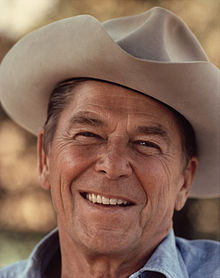 Ronald Reagan in 1976 at his home at Rancho del Cielo
Ronald Reagan in 1976 at his home at Rancho del Cielo
Howard Kurtz of The Washington Post has opined that Reagan was "a far more controversial figure in his time than the largely gushing obits on television would suggest."[292] As Kurtz' assertion suggests, there remains substantial and often broadly polarized debate surrounding Reagan and his legacy. Supporters have pointed to a more efficient and prosperous economy,[293] and a peaceful end to the Cold War,[294] while critics contend that Reagan's policies caused huge budget deficits that quadrupled the United States national debt,[130] and lowered American credibility in wake of the Iran-Contra affair.[295] Reagan was also criticized for initially failing to address the AIDS crisis.[296] Regardless of the debates, Reagan has generally ranked among the most popular of all modern U.S. presidents in public opinion polls.[297]
Edwin Feulner, President of The Heritage Foundation, said that Reagan "helped create a safer, freer world" and said of his economic policies: "He took an America suffering from 'malaise'... and made its citizens believe again in their destiny."[298] However, Mark Weisbrot, co-Director of the Center for Economic and Policy Research, said that Reagan's "economic policies were mostly a failure";[299] with Reagan's detractors accusing him of creating a range of fiscal calamities such as widening the wealth inequality to the point where the richest 1% of Americans held 39% of the nation's wealth, a rise in the poverty population from 26.1 million in 1979 to 32.7 million in 1988, and an increase in homelessness to 600,000 Americans on any given night.[139]
According to economist and author Jeffery Sachs, Reagan's approach to governance was not all that it seemed on the surface. Sachs states that Reagan's core diagnosis of an overreaching, dysfunctional government "was a fateful misdiagnosis" that caused him to overlook what Sachs asserts should have been the actual core issue during his presidency: "the rise of global competition in the information age." Reagan's oversight, according to Sachs, left America in a state he described as "singularly unprepared to face the global economic, energy and environmental challenges" as the dawn of a new century approached. As a result, according to Sachs, Reagan's presidency had the ironic affect of planting the seeds for a later era of broad-scale Progressivism, as those seeds have sought full fruition during what Sachs summarized as the discontented era that followed the Reagan era.[300]
Despite the continuing debate surrounding his legacy, many conservative and liberal scholars agree that Reagan has been the most influential president since Franklin D. Roosevelt, leaving his imprint on American politics, diplomacy, culture, and economics. Since he left office, historians have reached a consensus,[301] as summarized by British historian M. J. Heale, who finds that scholars now concur that Reagan rehabilitated conservatism, turned the nation to the right, practiced a considerably pragmatic conservatism that balanced ideology and the constraints of politics, revived faith in the presidency and in American self-respect, and, as seemed a major preoccupation of his, contributed to victory in the Cold War.[302]
The Ronald Reagan Presidential Library was dedicated on November 4, 1991.
Cold War
The Cold War was a major political and economic endeavor for over four decades, but the confrontation between the two superpowers had decreased dramatically by the end of Reagan's presidency.[303] The significance of Reagan's role in ending the Cold War has spurred contentious and opinionated debate.[304][305] That Reagan had some role in contributing to the downfall of the Soviet Union is collectively agreed, but the extent of this role is continuously debated,[226] with many believing that Reagan's defense policies, hard line rhetoric against the Soviet Union and Communism, as well as summits with General Secretary Gorbachev played a significant part in ending the War.[138][226]
 United States President Ronald Reagan (left) and President of the Soviet Union Mikhail Gorbachev meet in 1985.
United States President Ronald Reagan (left) and President of the Soviet Union Mikhail Gorbachev meet in 1985.
He was notable amongst post–World War II presidents as being convinced that the Soviet Union could be defeated rather than simply negotiated with,[226] a conviction that was vindicated by Gennadi Gerasimov, the Foreign Ministry spokesman under Gorbachev, who said that Star Wars was "very successful blackmail. ... The Soviet economy couldn't endure such competition."[306] Reagan's strong rhetoric toward the nation had mixed effects; Jeffery W. Knopf, PhD observes that being labeled "evil" probably made no difference to the Soviets but gave encouragement to the East-European citizens opposed to communism.[226] That Reagan had little or no effect in ending the Cold War is argued with equal weight; that Communism's internal weakness had become apparent, and the Soviet Union would have collapsed in the end regardless of who was in power.[226] President Harry Truman's policy of containment is also regarded as a force behind the fall of the U.S.S.R., and the Soviet invasion of Afghanistan undermined the Soviet system itself.[305]
General Secretary Gorbachev said of his former rival's Cold War role: "[He was] a man who was instrumental in bringing about the end of the Cold War,"[307] and deemed him "a great President."[307] Gorbachev does not acknowledge a win or loss in the war, but rather a peaceful end; he said he was not intimidated by Reagan's harsh rhetoric.[308] Margaret Thatcher, former Prime Minister of the United Kingdom, said of Reagan, "he warned that the Soviet Union had an insatiable drive for military power... but he also sensed it was being eaten away by systemic failures impossible to reform."[309] She later said, "Ronald Reagan had a higher claim than any other leader to have won the Cold War for liberty and he did it without a shot being fired."[310] Said Brian Mulroney, former Prime Minister of Canada: "He enters history as a strong and dramatic player [in the Cold War]."[311] Former President Lech Wałęsa of Poland acknowledged, "Reagan was one of the world leaders who made a major contribution to communism's collapse."[312]
Domestic and political legacy
Ronald Reagan reshaped the Republican party, led the modern conservative movement, and altered the political dynamic of the United States.[313] More men voted Republican under Reagan, and Reagan tapped into religious voters.[313] The so-called "Reagan Democrats" were a result of his presidency.[313]
Since leaving office, Reagan has become an iconic influence within the Republican party.[314] His policies and beliefs have been frequently invoked by Republican presidential candidates since 1989.[22] The 2008 Republican presidential candidates were no exception, for they aimed to liken themselves to him during the primary debates, even imitating his campaign strategies.[315] Republican nominee John McCain frequently stated that he came to office as "a foot soldier in the Reagan Revolution".[316] Lastly, Reagan's most famous statement that "Government is not a solution to our problem, government is the problem", has become the unofficial slogan for the rise of conservative commentators like Glenn Beck and Rush Limbaugh; as well as the emergence of the Tea Party Movement.[139]
Cultural and political image
According to columnist Chuck Raasch, "Reagan transformed the American presidency in ways that only a few have been able to."[317] He redefined the political agenda of the times, advocating lower taxes, a conservative economic philosophy, and a stronger military.[318] His role in the Cold War further enhanced his image as a different kind of leader.[319][320] Reagan's "avuncular style, optimism, and plain-folks demeanor" also helped him turn "government-bashing into an art form."[139]
Ronald Reagan's approval ratings Date Event Approval (%) Disapproval (%) March 30, 1981 Shot by Hinckley 73 19 January 22, 1983 High unemployment 42 54 April 26, 1986 Libya bombing 70 26 February 26, 1987 Iran-Contra affair 44 51 January 20, 1989 End of presidency 64 n/a Career Average 57 39 July 30, 2001 (Retrospective)[297] 64 27 As a sitting president, Reagan did not have the highest approval ratings,[321] but his popularity has increased since 1989. Gallup polls in 2001 and 2007 ranked him number one or number two when correspondents were asked for the greatest president in history, and third of post–World War II presidents in a 2007 Rasmussen Reports poll, fifth in an ABC 2000 poll, ninth in another 2007 Rasmussen poll, and eighth in a late 2008 poll by United Kingdom newspaper The Times.[322][323][324] In a Siena College survey of over 200 historians, however, Reagan ranked sixteenth out of 42.[325][326] While the debate about Reagan's legacy is ongoing, the 2009 Annual C-SPAN Survey of Presidential Leaders ranked Reagan the 10th greatest president. The survey of leading historians rated Reagan number 11 in 2000.[327]
In 2011, the Institute for the Study of the Americas released the first ever U.K. academic survey to rate U.S. presidents. This poll of U.K. specialists in U.S. history and politics placed Reagan as the 8th greatest U.S. president.[328]
Reagan's ability to connect with the American people[329] earned him the laudatory moniker "The Great Communicator".[330] Of it, Reagan said, "I won the nickname the great communicator. But I never thought it was my style that made a difference—it was the content. I wasn't a great communicator, but I communicated great things."[331] His age and soft-spoken speech gave him a warm grandfatherly image.[332][333][334]
Reagan also earned the nickname "the Teflon President," in that public perceptions of him were not tarnished by the controversies that arose during his administration.[335] According to Congresswoman Patricia Schroeder, who coined the phrase, and reporter Howard Kurtz, the epithet referred to Reagan's ability to "do almost anything wrong[335] and not get blamed for it."[329][336]
Public reaction to Reagan was always mixed; the oldest president was supported by young voters, and began an alliance that shifted many of them to the Republican party.[337] Reagan did not fare well with minority groups, especially African-Americans.[191] This was largely due to his opposition to affirmative action policies.[338] However, his support of Israel throughout his presidency earned him support from many Jews, and he became the first Republican ever to win the Jewish vote.[339] He emphasized family values in his campaigns and during his presidency, although he was the first president to have been divorced.[340] The combination of Reagan's speaking style, unabashed patriotism, negotiation skills, as well as his savvy use of the media, played an important role in defining the 1980s and his future legacy.[341]
Reagan was known to gibe frequently during his lifetime, displayed humor throughout his presidency,[342] and was famous for his storytelling.[343] His numerous jokes and one-liners have been labeled "classic quips" and "legendary".[344] Among the most notable of his jokes was one regarding the Cold War. As a sound check prior to his weekly radio address in August 1984, Reagan made the following joke as a way to test the microphone: "My fellow Americans, I'm pleased to tell you today that I've signed legislation that will outlaw Russia forever. We begin bombing in five minutes."[345] Former aide David Gergen commented, "It was that humor... that I think endeared people to Reagan."[185]
Honors
Further information: List of honors named for Ronald ReaganReagan received a number of awards in his pre- and post-presidential years. Following his election as president, Reagan received a lifetime gold membership in the Screen Actors Guild, was inducted into the National Speakers Association Speaker Hall of Fame[346] and received the United States Military Academy's Sylvanus Thayer Award.[347]
In 1989, Reagan was made an Honorary Knight Grand Cross of the Order of the Bath, one of the highest British orders (this entitled him to the use of the post-nominal letters "GCB" but, by not being the citizen of a Commonwealth realm, not to be known as "Sir Ronald Reagan"); only two American presidents have received this honor, Reagan and George H.W. Bush.[348] Reagan was also named an honorary Fellow of Keble College, Oxford. Japan awarded him the Grand Cordon of the Order of the Chrysanthemum in 1989; he was the second American president to receive the order and the first to have it given to him for personal reasons (Dwight D. Eisenhower received it as a commemoration of U.S.-Japanese relations).[349]
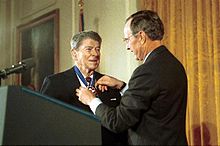 Former President Ronald Reagan returns to the White House to receive the Presidential Medal of Freedom from President George H.W. Bush in 1993
Former President Ronald Reagan returns to the White House to receive the Presidential Medal of Freedom from President George H.W. Bush in 1993
On January 18, 1993, Reagan's former Vice-President and sitting President George H. W. Bush awarded him the Presidential Medal of Freedom, the highest honor that the United States can bestow.[350] Reagan was also awarded the Republican Senatorial Medal of Freedom, the highest honor bestowed by Republican members of the Senate.[351]
On Reagan's 87th birthday, in 1998, Washington National Airport was renamed Ronald Reagan Washington National Airport by a bill signed into law by President Bill Clinton. That year, the Ronald Reagan Building and International Trade Center was dedicated in Washington, D.C.[352] He was among 18 included in Gallup's List of Widely Admired People of the 20th Century, from a poll conducted of the American people in 1999; two years later, USS Ronald Reagan was christened by Nancy Reagan and the United States Navy. It is one of few Navy ships christened in honor of a living person and the first aircraft carrier to be named in honor of a living former president.[353]
 A bronze statue of Reagan stands in the Capitol rotunda as part of the National Statuary Hall Collection.
A bronze statue of Reagan stands in the Capitol rotunda as part of the National Statuary Hall Collection.
Congress authorized the creation of the Ronald Reagan Boyhood Home National Historic Site in Dixon, Illinois in 2002, pending federal purchase of the property.[354] On May 16 of that year, Nancy Reagan accepted the Congressional Gold Medal, the highest civilian honor bestowed by Congress, on behalf of the president and herself.[355]
Following Reagan's death, the United States Postal Service issued a President Ronald Reagan commemorative postage stamp in 2005.[356] Later in the year, CNN, along with the editors of TIME magazine, named him the "most fascinating person" of the network's first 25 years;[357] Time listed Reagan one of the 100 Most Important People of the 20th century as well.[358] The Discovery Channel asked its viewers to vote for The Greatest American in an unscientific poll on June 26, 2005; Reagan received the honorary title.[359]
In 2006, Reagan was inducted into the California Hall of Fame, located at The California Museum for History, Women, and the Arts.[360] Every year since 2002, California Governors Gray Davis and Arnold Schwarzenegger have proclaimed February 6 "Ronald Reagan Day" in the state of California in honor of their most famous predecessor.[361] In 2010, Schwarzenegger signed Senate Bill 944, authored by Senator George Runner, to make every February 6 Ronald Reagan Day in California.[362]
In 2007, Polish President Lech Kaczyński posthumously conferred on Reagan the highest Polish distinction, the Order of the White Eagle, saying that Reagan had inspired the Polish people to work for change and helped to unseat the repressive communist regime; Kaczyński said it "would not have been possible if it was not for the tough-mindedness, determination, and feeling of mission of President Ronald Reagan".[363] Reagan backed the nation of Poland throughout his presidency, supporting the anti-communist Solidarity movement, along with Pope John Paul II.[364]
On June 3, 2009, Nancy Reagan unveiled a statue of her late husband in the United States Capitol rotunda. The statue represents the state of California in the National Statuary Hall Collection. Following Reagan's death, both major American political parties agreed to erect a statue of Reagan in the place of that of Thomas Starr King.[365] The day before, President Obama signed the Ronald Reagan Centennial Commission Act into law, establishing a commission to plan activities to mark the upcoming centenary of Reagan's birth.[366]
Independence Day 2011 saw the unveiling of another statue to Reagan this time in the British capital of London, outside the American Embassy, Grosvenor Square. The unveiling was supposed to be attended by Reagan's wife Nancy, but she did not attend; former Secretary of State Condoleezza Rice took her place and read a statement on her behalf; further to the former First Lady's absence President Reagan's friend and the British Prime Minister during Reagan's presidency Baroness Thatcher was also unable to attend due to frail health.[367]
See also
- List of Presidents of the United States
- Political positions of Ronald Reagan
- US Presidents on US postage stamps
Citations
- ^ "The Evil Empire". American Heritage. Spring/Summer 2008. http://www.americanheritage.com/articles/magazine/ah/2008/4/2008_4_18.shtml. Retrieved July 22, 2010.
- ^ a b Ward, Michael. "Main Street Historic District", National Register of Historic Places Nomination Form, April 1, 1982, HAARGIS Database, Illinois Historic Preservation Agency. Retrieved July 27, 2007.
- ^ Terry Golway, Ronald Reagan's America (2008) p. 1
- ^ Kengor, p. 4
- ^ Lynette Holloway (December 13, 1996). "Neil Reagan, 88, Ad Executive And Jovial Brother of President". The New York Times. http://www.nytimes.com/1996/12/13/us/neil-reagan-88-ad-executive-and-jovial-brother-of-president.html. Retrieved March 22, 2009.
- ^ a b "Ronald Reagan Facts". Ronald Reagan Presidential Foundation. http://www.reagan.utexas.edu/archives/reference/facts.html. Retrieved June 9, 2007.
- ^ Schribman, David (June 6, 2004). "Reagan, all-American, dies at 93". The Boston Globe. http://www.boston.com/news/nation/articles/2004/06/06/reagan_all_american_dies_at_93/. Retrieved January 17, 2008.
- ^ a b Kengor, p. 16
- ^ Lewis, Warren and Rollmann, Hans, ed (2005). Restoring the First-century Church in the Twenty-first Century. Wipf and Stock. pp. 181–192. ISBN 1597524166.
- ^ Kengor, p. 15
- ^ Cannon (2001), p. 2
- ^ Reagan (1990), p. 27
- ^ "School House to White House: The Education of the Presidents". National Archives and Records Administration. http://www.archives.gov/publications/prologue/2007/spring/schoolhouse.html. Retrieved December 30, 2007.
- ^ a b "Ronald Reagan (1911–2004): Small town to tinseltown". CNN, 2004. Retrieved on August 15, 2007.
- ^ Cannon (2003), p. 25; Reagan (1990) p. 48
- ^ "U.S. Army Reserve-History". Global Security.com. http://www.globalsecurity.org/military/agency/army/usar-history.htm. Retrieved December 30, 2007.
- ^ a b c d "Military service of Ronald Reagan". Ronald Reagan Presidential Library. http://www.reagan.utexas.edu/archives/reference/military.html. Retrieved June 22, 2007.
- ^ "History of the 11th Armored Cavalry Regiment". 11th Armored Cavalry Regiment. Archived from the original on July 1, 2007. http://web.archive.org/web/20070701172746/http://www.irwin.army.mil/Units/11TH+Armored+Cavalry+Regiment/11thACR/. Retrieved November 10, 2008.
- ^ "USS Ronald Reagan: Ronald Reagan". United States Navy. Archived from the original on October 30, 2007. http://web.archive.org/web/20071030073032/http://www.reagan.navy.mil/about_reagan.html. Retrieved March 7, 2007.
- ^ a b c "President Ronald Reagan". National Museum of the United States Air Force. http://www.nationalmuseum.af.mil/factsheets/factsheet.asp?id=1660. Retrieved December 30, 2007.
- ^ a b "Ronald Reagan 1911–2004". Tampico, Illinois Historical Society. http://www.tampicohistoricalsociety.citymax.com/Ronald_Reagan_History_Tampico.html. Retrieved December 30, 2007.
- ^ a b c d e f g h i j k l m Cannon, Lou (June 6, 2004). "Actor, Governor, President, Icon". The Washington Post: p. A01. http://www.washingtonpost.com/wp-dyn/articles/A18329-2004Jun5.html. Retrieved January 26, 2008.
- ^ Wills, pp. 109–110
- ^ "Biography > A Hero from the Heartland". Ronald Reagan Presidential Foundation. Archived from the original on October 31, 2007. http://web.archive.org/web/20071031092212/http://www.reaganfoundation.org/reagan/biography/a_hero.asp. Retrieved December 30, 2007.
- ^ "Ronald Reagan > Hollywood Years". Ronald Reagan Presidential Foundation. Archived from the original on March 12, 2007. http://web.archive.org/web/20070312120428/http://www.reaganfoundation.org/reagan/biography/hollywood_years.asp. Retrieved March 28, 2007.
- ^ a b Cannon (2001), p. 15
- ^ a b Reagan, Ronald (1965). Where's the Rest of Me?. New York: Duell, Sloan, and Pearce. ISBN 0283987715.
- ^ Wood, Brett. "Kings Row". TCM website. Turner Classic Movies. http://www.tcm.com/thismonth/article/?cid=17922. Retrieved March 24, 2009.
- ^ Crowther, Bosley (February 3, 1942). "The Screen; 'Kings Row,' With Ann Sheridan and Claude Rains, a Heavy, Rambling Film, Has Its First Showing Here at the Astor". The New York Times. http://movies2.nytimes.com/mem/movies/review.html?res=9903E2DE143BE33BBC4B53DFB4668389659EDE. Retrieved March 29, 2007.
- ^ Cannon (2003), pp. 56–57
- ^ a b Friedrich, Otto (1997). City of nets: a portrait of Hollywood in the 1940s. University of California Press (reprint). pp. 86–89. ISBN 978-0520209497. http://books.google.com/?id=1Y9uZw7YNK8C&printsec=frontcover&dq=city+of+nets.
- ^ a b "Ronald Reagan". Internet Movie Database. http://www.imdb.com/name/nm0001654/. Retrieved December 30, 2007.
- ^ according to Reagan: A Life in Letters, (pp. 836–837).
- ^ Kiron K. Skinner, Ronald Reagan, Annelise Anderson, Martin Anderson, George P. Shultz Reagan: A Life In Letters, Simon & Schuster, 2004 ISBN 0-7432-1967-8 p. 836
- ^ Mother signs best, New York Magazine, Feb 18, 1985
- ^ a b c d "Screen Actors Guild Presidents: Ronald Reagan". Screen Actors Guild. Archived from the original on December 28, 2007. http://web.archive.org/web/20071228063556/http://www.sag.org/history/presidents/reagan.html. Retrieved November 10, 2008.
- ^ "American Notes Hollywood". Time. September 9, 1985. http://www.time.com/time/magazine/article/0,9171,142352,00.html. Retrieved April 21, 2009.
- ^ a b "House Un-American Activities Committee Testimony: Ronald Reagan". Tennessee Wesleyan College. October 23, 1947. http://www.twcnet.edu/cschutz/history-page/Consensus/Reagan-huac-testimony.html. Retrieved December 30, 2007.
- ^ A Turkey for the President (TV episode 1958 #7.10), IMDB.
- ^ "Dispute Over Theatre Splits Chicago City Council". The New York Times. May 8, 1984. http://query.nytimes.com/gst/fullpage.html?sec=travel&res=9407E6DA1138F93BA35756C0A962948260. Retrieved May 17, 2007.
- ^ Oliver, Marilyn (March 31, 1988). "Locations Range From the Exotic to the Pristine". The Los Angeles Times.
- ^ "Jane Wyman: Biography". JaneWyman.com. http://www.jane-wyman.com/biography.html. Retrieved December 31, 2007.
- ^ Severo, Richard (September 11, 2007). "Jane Wyman, 90, Star of Film and TV, Is Dead". The New York Times. http://www.nytimes.com/2007/09/11/movies/11wyman.html. Retrieved December 31, 2007.
- ^ Slovick, Matt (July 23, 1997). "The American President". The Washington Post. http://www.washingtonpost.com/wp-srv/style/longterm/movies/features/dcmovies/americanpresident.htm. Retrieved December 31, 2007.
- ^ "Nancy Reagan > Her Life & Times". Ronald Reagan Presidential Foundation. Archived from the original on November 12, 2007. http://web.archive.org/web/20071112053844/http://www.reaganfoundation.org/reagan/nancy/nancy_bio.asp. Retrieved October 29, 2007.
- ^ a b c d "End of a Love Story". BBC. June 5, 2004. http://news.bbc.co.uk/1/hi/world/americas/265714.stm. Retrieved March 21, 2007.
- ^ "Nancy Davis Reagan". The White House. http://www.whitehouse.gov/history/firstladies/nr40.html. Retrieved January 13, 2008.
- ^ Beschloss, p. 296
- ^ a b Berry, Deborah Barfield (June 6, 2004). "By Reagan's Side, but her own person". Newsday. http://www.newsday.com/news/nationworld/nation/ny-usnanc063835985jun06,0,3872519.story?coll=ny-nationalnews-headlines. Retrieved August 15, 2007.
- ^ "Reagan Love Story". MSNBC. June 9, 2004. http://www.msnbc.msn.com/id/4201869/. Retrieved May 25, 2007.
- ^ Beschloss, p. 284
- ^ "Nancy Reagan". Nndb.com. http://www.nndb.com/people/870/000022804/. Retrieved 2011-08-12.
- ^ "An American Life: The Autobiography by Ronald Reagan". LibraryThing. http://www.librarything.com/work/109910. Retrieved 2011-08-12.
- ^ Pemberton (1998) pp. 29–31; Reagan (1990), p. 132.
- ^ "The Crist Switch: Top 10 Political Defections". Time. April 29, 2009. http://www.time.com/time/specials/packages/article/0,28804,1894529_1894528_1894518,00.html.
- ^ a b "Corporate spokesman and rising conservative - Ronald Reagan - policy, election, foreign". Presidentprofiles.com. http://www.presidentprofiles.com/Kennedy-Bush/Ronald-Reagan-Corporate-spokesman-and-rising-conservative.html. Retrieved 2011-08-12.
- ^ "The Education of Ronald Reagan". Cup.columbia.edu. http://cup.columbia.edu/book/978-0-231-13860-4/the-education-of-ronald-reagan. Retrieved 2011-08-12.
- ^ Thomas W. Evans, The Education of Ronald Reagan: The General Electric Years and the Untold Story of His Conversion to Conservatism (2008).
- ^ Cannon (2003), p. 113.
- ^ Hayward, p. 635.
- ^ Kyle Longley Deconstructing Reagan: conservative mythology and America's fortieth president, M.E. Sharpe, 2007 ISBN 0-7656-1590-8 p. 76.
- ^ News Hour with Jim Lehrer: Historians reflect on former President Ronald Reagan's legacy in U.S. politics, News Hour with Jim Lehrer: Historians reflect on former President Ronald Reagan's legacy, June 7, 2004 – Roger Wilkins commented on Reagan's Jefferson Davis remark. Wilkins also said the following: "I had one extraordinary conversation with him in which he called me to tell me he wasn't a racist because I had attacked his South Africa policy in a newspaper column and he was very disturbed by the implication that this had any... he spent 30 minutes on the telephone trying to convince me about it, and talked about how he had played football with black guys in high school and college in order to try to make that point."
- ^ 1 augustus 2007. "Ronald Reagan Speaks Out Against Socialized Medicine". YouTube. http://www.youtube.com/watch?v=fRdLpem-AAs. Retrieved March 8, 2010.
- ^ Posted by JohnL at July 23, 2004 12:01 am (July 23, 2004). "Operation Coffee Cup". Texasbestgrok.mu.nu. http://texasbestgrok.mu.nu/archives/038360.php. Retrieved March 8, 2010.
- ^ Richard Rapaport, June 21, 2009, San Francisco ChronicleHow AMA 'Coffeecup' gave Reagan a boost.
- ^ "A Time for Choosing". PBS. http://www.pbs.org/wgbh/amex/presidents/40_reagan/psources/ps_choose64.html. Retrieved April 17, 2007.
- ^ Cannon (2001), p. 36.
- ^ Tatalovich, Raymond; Byron W. Daynes, Theodore J Lowi (2010). Moral Controversies in American Politics (4 ed.). M.E. Sharpe. p. 172. ISBN 9780765626516. http://books.google.com/?id=NT50S7-X0jMC&pg=PA172&dq=president+kennedy+national+rifle+association+life+member#v=onepage&q=president%20kennedy%20national%20rifle%20association%20life%20member&f=false.
- ^ "The Governors' Gallery – Ronald Reagan". California State Library. http://governors.library.ca.gov/33-Reagan.html. Retrieved March 21, 2007.
- ^ Kahn, Jeffery (June 8, 2004). "Ronald Reagan launched political career using the Berkeley campus as a target". UC Berkeley News. http://www.berkeley.edu/news/media/releases/2004/06/08_reagan.shtml. Retrieved March 30, 2007.
- ^ Cannon (2001), p. 47.
- ^ a b *Fischer, Klaus (2006). America in White, Black, and Gray: The Stormy 1960s. Continuum. pp. 241–243. ISBN 0826418163. http://books.google.com/books?id=sCXig_6abwkC&pg=PA241.
- ^ "The New Rules of Play". Time. March 8, 1968. http://www.time.com/time/magazine/article/0,9171,899963,00.html. Retrieved October 16, 2007.
- ^ a b c Cannon, Lou (2001), p. 50.
- ^ "Postscript to People's Park". Time. February 16, 1970. http://www.time.com/time/magazine/article/0,9171,904149,00.html. Retrieved December 9, 2007.
- ^ Cannon, Lou (2003), p. 295.
- ^ "Reagan Raps Press on Botulism Quote". The Los Angeles Times (Los Angeles, California). March 14, 1974.
- ^ a b c Cannon (2001), p. 51
- ^ Reagan, Ronald. (1984) Abortion and the conscience of the nation. Nashville: T. Nelson. ISBN 0-8407-4116-2
- ^ Recall Idea Got Its Start in L.A. in 1898, Los Angeles Times, July 13, 2003
- ^ Seneker, Carl J (May 1967). "Governor Reagan and Executive Clemency". California Law Review (JSTOR) 55 (2): 412–418. doi:10.2307/3479351. JSTOR 3479351.
- ^ 1969 Cal. Stats. chapter 1608, page 3313
- ^ Kubarych, Roger M (June 9, 2004). "The Reagan Economic Legacy". Council on Foreign Relations. http://www.cfr.org/publication/7092/reagan_economic_legacy.html. Retrieved August 22, 2007.
- ^ "Biography of Gerald R. Ford". The White House. http://www.whitehouse.gov/history/presidents/gf38.html. Retrieved March 29, 2007. Ford considered himself a "a moderate in domestic affairs, a conservative in fiscal affairs, and a dyed-in-the-wool internationalist in foreign affairs".
- ^ "Candidate Reagan is Born Again". Time. September 24, 1979. http://www.time.com/time/magazine/article/0,9171,947391-2,00.html. Retrieved May 10, 2008.
- ^ a b "1976 New Hampshire presidential Primary, February 24, 1976 Republican Results". New Hampshire Political Library. Archived from the original on October 6, 2006. http://web.archive.org/web/20061006023552/http://www.politicallibrary.org/TallState/1976rep.html. Retrieved November 10, 2008.
- ^ Hathorn Billy (2010). "Mayor Ernest Angelo, Jr., of Midland and the 96–0 Reagan Sweep of Texas, May 1, 1976". West Texas Historical Association Yearbook 86: 77–91.
- ^ "Electoral College Box Scores 1789–1996". U.S. National Archives and Records Admin.. http://www.archives.gov/federal-register/electoral-college/scores.html#1976. Retrieved April 30, 2007.
- ^ Uchitelle, Louis (September 22, 1988). "Bush, Like Reagan in 1980, Seeks Tax Cuts to Stimulate the Economy". The New York Times. http://query.nytimes.com/gst/fullpage.html?res=940DEED9163BF931A1575AC0A96E948260. Retrieved February 6, 2008.
- ^ a b Hakim, Danny (March 14, 2006). "Challengers to Clinton Discuss Plans and Answer Questions". The New York Times. http://www.nytimes.com/2006/03/14/nyregion/14repubs.html?_r=1&scp=3&sq=reagan+lower+government&st=nyt&oref=slogin. Retrieved February 6, 2008.
- ^ Kneeland, Douglas E. (August 4, 1980) "Reagan Campaigns at Mississippi Fair; Nominee Tells Crowd of 10,000 He Is Backing States' Rights". The New York Times. p. A11. Retrieved on January 1, 2008
- ^ Campaign ad on video http://www.youtube.com/watch?v=qxEq2LWUPzc
- ^ John David Lees, Michael Turner. Reagan's first four years: a new beginning? Manchester University Press ND, 1988. p. 11
- ^ "Reagan, the South and Civil Rights". National Public Radio. http://www.npr.org/templates/story/story.php?storyId=1953700. Retrieved April 27, 2008.
- ^ Herbert, Bob (November 13, 2007). "Righting Reagan's Wrongs?". The New York Times. http://www.nytimes.com/2007/11/13/opinion/13herbert.html?_r=1&hp&oref=slogin. Retrieved April 27, 2008.
- ^ Krugman, Paul (November 10, 2007). "Innocent mistakes". The New York Times. http://krugman.blogs.nytimes.com/2007/11/10/innocent-mistakes/. Retrieved April 27, 2008.
- ^ "1980 Presidential Election Results". Atlas of U.S. Presidential Elections. http://uselectionatlas.org/RESULTS/national.php?year=1980. Retrieved March 28, 2007.
- ^ Reagan, Ronald (1978-11-01). "Editorial: Two Ill-advised California Trends". Los Angeles Herald-Examiner. p. A19.
- ^ a b *Freidel, Frank; Sidey, Hugh (1995). The Presidents of the United States of America. Washington, D.C.: White House Historical Association. p. 84. ISBN 0912308575.
- ^ Hayward, Steven F (May 16, 2005). "Reagan in Retrospect". American Enterprise Institute for Public Policy Research. http://www.aei.org/publications/pubID.22519/pub_detail.asp. Retrieved April 7, 2009.
- ^ Cannon (1991, 2000), p. 746
- ^ Reagan, Ronald (2007). The Reagan Diaries. Harper Collins. ISBN 006087600X. http://www.harpercollins.com/books/9780060876005/The_Reagan_Diaries/index.aspx. Retrieved June 5, 2007.
- ^ "Ronald Reagan dies at 93". CNN. June 5, 2004. http://www.cnn.com/2004/ALLPOLITICS/06/05/reagan.health/index.html. Retrieved February 24, 2008.
- ^ Murray, Robert K.; Tim H. Blessing (1993). Greatness in the White House. Penn State Press. p. 80. ISBN 0271024860.
- ^ "Iran Hostage Crisis: November 4, 1979 to January 20, 1981". Online Highways. 2005. http://www.u-s-history.com/pages/h2021.html. Retrieved May 11, 2007.
- ^ "Remembering the Assassination Attempt on Ronald Reagan". CNN. March 30, 2001. http://transcripts.cnn.com/TRANSCRIPTS/0103/30/lkl.00.html. Retrieved December 19, 2007.
- ^ D'Souza, Dinesh (June 8, 2004). "Purpose". National Review. http://www.nationalreview.com/comment/dsouza200406080824.asp. Retrieved February 16, 2009.
- ^ Langer, Gary (June 7, 2004). "Reagan's Ratings: ‘Great Communicator's’ Appeal Is Greater in Retrospect". ABC. http://abcnews.go.com/sections/us/Polls/reagan_ratings_poll_040607.html. Retrieved May 30, 2008.
- ^ Kengor, Paul (2004). "Reagan's Catholic Connections". Catholic Exchange. http://www.catholiceducation.org/articles/catholic_stories/cs0080.html. Retrieved May 30, 2008.
- ^ http://www.americanambassadors.org/index.cfm?fuseaction=publications.article&articleid=44 "United States-Vatican Diplomatic Relations: The Past and The Future". Council of American Ambassadors.
- ^ Herbert R. Northrup, "The Rise And Demise Of Patco," Industrial and Labor Relations Review, Jan 1984, Vol. 37 Issue 2, pp 167–184
- ^ "Remarks and a Question-and-Answer Session With Reporters on the Air Traffic Controllers Strike". Ronald Reagan Presidential Foundation. 1981. http://www.reagan.utexas.edu/archives/speeches/1981/80381a.htm. Retrieved May 13, 2007.
- ^ "Unhappy Again". Time. October 6, 1986. http://www.time.com/time/magazine/article/0,9171,962487,00.html. Retrieved August 15, 2007.
- ^ David Schultz, Encyclopedia of public administration and public policy (2004) p 359
- ^ Cannon (1991, 2000), p. 235.
- ^ "Employment status of the civilian noninstitutional population 16 years and over, 1940 to date". United States Bureau of Labor Statistics. http://www.bls.gov/cps/prev_yrs.htm. Retrieved December 6, 2010.
- ^ Karaagac, John (2000). Ronald Reagan and Conservative Reformism. Lexington Books. p. 113. ISBN 0739102966. http://books.google.com/books?id=ZFhGnjKqjgAC&pg=PA113.
- ^ Cannon (2001) p. 99
- ^ Hayward, pp. 146–48
- ^ a b Bartels, Larry M., L. M. (June 1, 1991). "Constituency Opinion and Congressional Policy Making: The Reagan Defense Build Up". The American Political Science Review 85 (2): 457–474. doi:10.2307/1963169. ISSN 00030554. JSTOR 1963169.
- ^ Mitchell, Daniel J. PhD (July 19, 1996). "The Historical Lessons of Lower Tax Rates". The Heritage Foundation. http://www.heritage.org/Research/Taxes/BG1086.cfm. Retrieved May 22, 2007.
- ^ Sahadi, Jeanne. "Taxes: What people forget about Reagan." CNN, September 12, 2010.
- ^ Bruce Bartlett on Tax Increases & Reagan on NRO Financial. Old.nationalreview.com (October 29, 2003). Retrieved on August 14, 2010.
- ^ a b Higher Taxes: Will The Republicans Cry Wolf Again?. Forbes.com. Retrieved on August 14, 2010.
- ^ OTA Paper 81 – Revenue Effects of Major Tax Bills – revised September 2006. (PDF) . Retrieved on August 14, 2010.
- ^ Krugman, Paul (June 8, 2004). "The Great Taxer". The New York Times. http://www.nytimes.com/2004/06/08/opinion/the-great-taxer.html?pagewanted=1. Retrieved March 30, 2010.
- ^ Even Reagan Raised Taxes. Forbes.com. Retrieved on August 14, 2010.
- ^ "Gross Domestic Product" (Excel). Bureau of Economic Analysis. July 27, 2007. http://www.bea.gov/national/xls/gdpchg.xls. Retrieved August 15, 2007.
- ^ Hayward, p. 185
- ^ a b c Cannon (2001), p. 128
- ^ <Please add first missing authors to populate metadata.> (2003, rev. September 2006) (PDF). Revenue Effects of Major Tax Bills. United States Department of the Treasury, Office of Tax Analysis. Working Paper 81, Table 2. http://www.ustreas.gov/offices/tax-policy/library/ota81.pdf. Retrieved November 28, 2007.
- ^ "Historical Budget Data". Congressional Budget Office. March 20, 2009. Archived from the original on July 30, 2008. http://web.archive.org/web/20080730192808/http://www.cbo.gov/budget/historical.shtml. Retrieved August 10, 2009.
- ^ "Federal Budget Receipts and Outlays". Presidency.ucsb.edu. http://www.presidency.ucsb.edu/data/budget.php. Retrieved March 8, 2010.
- ^ "Annual Statistical Supplement, 2008 – Old-Age, Survivors, and Disability Insurance Trust Funds (4.A)" (PDF). http://www.socialsecurity.gov/history/pdf/4a.pdf. Retrieved March 8, 2010.
- ^ Birnbaum, Jeffrey H (October 22, 2006). "Taxing Lessons, 20 Years In the Making". The Washington Post: p. B02. http://www.washingtonpost.com/wp-dyn/content/article/2006/10/20/AR2006102001255.html. Retrieved September 13, 2008.
- ^ Gwartney, James D. "Supply-Side Economics". The Concise Encyclopedia of Economics. http://www.econlib.org/library/Enc/SupplySideEconomics.html. Retrieved August 21, 2007.
- ^ "Reaganomics". PBS. June 10, 2004. http://www.pbs.org/newshour/bb/economy/jan-june04/reagan_6-10-04.html. Retrieved August 21, 2007.
- ^ a b c Meacham, John; Andrew Murr, Eleanor Clift, Tamara Lipper, Karen Breslau, and Jennifer Ordonez (June 14, 2004). "American Dreamer". Newsweek. http://www.newsweek.com/id/54017?tid=relatedcl. Retrieved June 3, 2008.
- ^ a b c d Don't add Reagan's Face to Mount Rushmore by Dr. Peter Dreier, The Nation, April 3, 2011
- ^ a b Rosenbaum, David E (January 8, 1986). "Reagan insists Budget Cuts are way to Reduce Deficit". The New York Times. http://query.nytimes.com/gst/fullpage.html?sec=health&res=9A0DE3DE1630F93BA35752C0A960948260. Retrieved August 21, 2008.
- ^ "Ronald Reagan: Presidency>>Domestic policies". Encyclopædia Britannica. http://www.britannica.com/EBchecked/topic/492882/Ronald-W-Reagan/214230/Domestic-policies. Retrieved August 21, 2008.
- ^ "Views from the Former Administrators". EPA Journal. Environmental Protection Agency. November 1985. http://www.epa.gov/history/topics/epa/15e.htm. Retrieved August 21, 2008.
- ^ "The Reagan Presidency". Reagan Presidential Foundation. http://www.reagan.utexas.edu/archives/reference/pressketch.html. Retrieved August 4, 2008.
- ^ Pear, Robert (April 19, 1992). "U.S. to Reconsider Denial of Benefits to Many Disabled". The New York Times. http://query.nytimes.com/gst/fullpage.html?res=9E0CE6D81738F93AA25757C0A964958260&sec=&spon=&pagewanted=all. Retrieved May 23, 2008.
- ^ Ely, Bert. "Savings and Loan Crisis". Liberty Fund, Inc.. http://www.econlib.org/Library/Enc/SavingsandLoanCrisis.html. Retrieved August 17, 2007.
- ^ Bergsten, C. Fred (2001). "Strong Dollar, Weak Policy" (Reprint). The International Economy. http://findarticles.com/p/articles/mi_m2633/is_4_15/ai_76994290/pg_3. Retrieved August 17, 2007.
- ^ Sornette, Didier; Johansen, Anders; &Amp,; Bouchaud, Jean-Philippe (1996). "Stock Market Crashes, Precursors and Replicas". Journal de Physique I 6 (1): 167–175. doi:10.1051/jp1:1996135.
- ^ "Historical Debt Outstanding". U.S. Treasury Department. http://www.treasurydirect.gov/govt/reports/pd/histdebt/histdebt_histo4.htm. Retrieved September 8, 2010.
- ^ Brandly, Mark (May 20, 2004). "Will We Run Out of Energy?". Ludwig von Mises Institute. http://www.mises.org/story/1519. Retrieved November 6, 2008.
- ^ Lieberman, Ben (September 1, 2005). "A Bad Response To Post-Katrina Gas Prices". The Heritage Foundation. http://www.heritage.org/Research/EnergyandEnvironment/wm827.cfm. Retrieved November 6, 2008.
- ^ Lieberman, Ben (September 1, 2005). "A Bad Response To Post-Katrina Gas Prices". Heritage Foundation. http://www.heritage.org/Research/EnergyandEnvironment/wm827.cfm. Retrieved November 6, 2008.
- ^ Thorndike, Joseph J. (November 10, 2005). "Historical Perspective: The Windfall Profit Tax—Career of a Concept". TaxHistory.org. http://www.taxhistory.org/thp/readings.nsf/cf7c9c870b600b9585256df80075b9dd/edf8de04e58e4b14852570ba0048848b. Retrieved November 6, 2008.
- ^ a b "Reagan's Economic Legacy". Business Week. June 21, 2004. http://www.businessweek.com/magazine/content/04_25/b3888032_mz011.htm. Retrieved July 1, 2007.
- ^ Koprowski, Gene (March 7, 1991). "Tech Intelligence Revival? Commerce May Model on DIA's Project Socrates". Washington Technology.
- ^ Smith, Esther (May 5, 1988). "DoD Unveils Competitive Tool: Project Socrates Offers Valuable Analysis". Washington Technology.
- ^ Bates, John D. (Presiding) (September 2003) (PDF). Anne Dammarell et al. v. Islamic Republic of Iran. District of Columbia, U.S.: The United States District Court for the District of Columbia. Archived from the original on November 7, 2006. http://web.archive.org/web/20061107234622/http://www.dcd.uscourts.gov/01-2224.pdf. Retrieved November 10, 2008.
- ^ "Report on the DoD Commission on Beirut International Airport Terrorist Act, October 23, 1983". HyperWar Foundation. December 20, 1983. http://www.ibiblio.org/hyperwar/AMH/XX/MidEast/Lebanon-1982-1984/DOD-Report/Beirut-8.html. Retrieved August 15, 2007.
- ^ Library of Congress Veterans History Project: Arnold Resnicoff collection, AFC/2001/001/70629, May 2010.
- ^ Hampson, Rick. "25 years later, bombing in Beirut still resonates." USA TODAY, October 15, 2008.
- ^ a b "Operation Agent Fury" (PDF). Defense Technical Information Center. Archived from the original on June 5, 2007. http://web.archive.org/web/20070605104546/http://www.dtic.mil/doctrine/jel/history/urgfury.pdf. Retrieved March 9, 2007.
- ^ Cooper, Tom. (September 1, 2003). "Grenada, 1983: Operation 'Urgent Fury'". Air Combat Information Group. http://www.acig.org/artman/publish/article_159.shtml. Retrieved April 8, 2007.
- ^ "Towards an International History of the War in Afghanistan, 1979–89". The Woodrow Wilson International Center for Scholars. 2002. http://www.wilsoncenter.org/index.cfm?topic_id=1409&fuseaction=topics.event_summary&event_id=12594. Retrieved May 16, 2007.
- ^ "LGM-118A Peacekeeper". Federation of American Scientists. August 15, 2000. http://www.fas.org/nuke/guide/usa/icbm/lgm-118.htm. Retrieved April 10, 2007.
- ^ "Großdemo gegen Nato-Doppelbeschluss, SPIEGEL on the mass protests against deployment of nuclear weapons in West Germany". http://einestages.spiegel.de/static/topicalbumbackground/2108/grossdemo_gegen_nato_doppelbeschluss.html.
- ^ Reagan, Ronald. (June 8, 1982). "Ronald Reagan Address to British Parliament". The History Place. http://www.historyplace.com/speeches/reagan-parliament.htm. Retrieved April 19, 2006.
- ^ "Reagan and Thatcher, political soul mates". Associated Press. MSNBC. June 5, 2004. http://www.msnbc.msn.com/id/5145739/. Retrieved June 24, 2008.
- ^ Robert C. Rowland, and John M. Jones. Reagan at Westminster: Foreshadowing the End of the Cold War (Texas A&M University Press; 2010)
- ^ Speeches to Both Houses, Parliamentary Information List, Standard Note: SN/PC/4092, Last updated: November 27, 2008, Author: Department of Information Services
- ^ "Former President Reagan Dies at 93". The Los Angeles Times. June 6, 2004. http://www.latimes.com/news/obituaries/la-reagan,1,4780792.story?page=6&coll=la-news-obituaries&ctrack=1&cset=true. Retrieved March 7, 2007.
- ^ Cannon (1991), pp. 314–317.
- ^ a b "1983:Korean Airlines flight shot down by Soviet Union". A&E Television. http://www.history.com/tdih.do?id=2777&action=tdihArticleCategory. Retrieved April 10, 2007.
- ^ Pace (1995). "GPS History, Chronology, and Budgets". The Global Positioning System. Rand. p. 248. http://www.rand.org/pubs/monograph_reports/MR614/MR614.appb.pdf.
- ^ Pellerin, United States Updates Global Positioning System Technology: New GPS satellite ushers in a range of future improvements
- ^ ""The Reagan Doctrine: The Guns of July," Foreign Affairs, Spring 1986". Foreignaffairs.org. March 1, 1986. http://www.foreignaffairs.org/19860301faessay7785/stephen-s-rosenfeld/the-reagan-doctrine-the-guns-of-july.html. Retrieved March 8, 2010.
- ^ Crile, George (2003). Charlie Wilson's War: The Extraordinary Story of the Largest Covert Operation in History. Atlantic Monthly Press. ISBN 0871138549.
- ^ Pach, Chester (2006). "The Reagan Doctrine: Principle, Pragmatism, and Policy". Presidential Studies Quarterly 36 (1): 75–88. doi:10.1111/j.1741-5705.2006.00288.x. JSTOR 27552748.
- ^ Coll, Steve (July 19, 1992). "Anatomy of a Victory: CIA's Covert Afghan War". The Washington Post. Global Issues. http://www.globalissues.org/article/258/anatomy-of-a-victory-cias-covert-afghan-war. Retrieved February 24, 2009.
- ^ Harnden, Toby (September 26, 2001). "Taliban still have Reagan's Stingers". The Telegraph (London). http://www.telegraph.co.uk/news/worldnews/asia/afghanistan/1357632/Taliban-still-have-Reagans-Stingers.html. Retrieved September 17, 2010.
- ^ Harrison, Selig S. "A Chinese Civil War." The National Interest, February 7, 2011.
- ^ a b c "Deploy or Perish: SDI and Domestic Politics". Scholarship Editions. http://content.cdlib.org/xtf/view?docId=ft4q2nb3c4&chunk.id=d0e5097&toc.id=d0e5097&brand=eschol. Retrieved April 10, 2007.
- ^ Adelman, Ken. (July 8, 2003). "SDI:The Next Generation". Fox News. http://www.foxnews.com/story/0,2933,91361,00.html. Retrieved March 15, 2007.
- ^ Beschloss, p. 293
- ^ a b "Foreign Affairs: Ronald Reagan". PBS. http://www.pbs.org/wgbh/amex/presidents/40_reagan/reagan_foreign.html. Retrieved June 6, 2007.
- ^ Beschloss, p. 294
- ^ a b Thomas, Rhys (Writer/Producer) (2005). The Presidents (Documentary). A&E Television. http://store.aetv.com/html/product/index.jhtml?id=71740.
- ^ "Los Angeles 1984". Swedish Olympic Committee. http://www.sok.se/inenglish/losangeles1984.4.18ea16851076df63622800011008.html. Retrieved March 7, 2007.
- ^ "The Debate: Mondale vs. Reagan". National Review. October 4, 2004. http://www.nationalreview.com/flashback/editors200410040912.asp. Retrieved May 25, 2007.
- ^ "Reaction to first Mondale/Reagan debate". PBS. October 8, 1984. http://www.pbs.org/newshour/debatingourdestiny/newshour/84_1stprez-analysis.html. Retrieved December 31, 2007.
- ^ "1984 Presidential Debates". CNN. http://cgi.cnn.com/ALLPOLITICS/1996/debates/history/1984/. Retrieved May 25, 2007.
- ^ a b "1984 Presidential Election Results". David Leip. http://uselectionatlas.org/RESULTS/national.php?year=1984. Retrieved May 25, 2007.
- ^ a b "The Reagan Presidency". Ronald Reagan Presidential Foundation. http://www.reagan.utexas.edu/archives/reference/pressketch.html. Retrieved April 19, 2008.
- ^ "Phil Gailey and Warren Weaver, Jr., "Briefing"". The New York Times, June 5, 1982. June 5, 1982. http://www.nytimes.com/1982/06/05/us/briefing-186924.html. Retrieved January 27, 2011.
- ^ Buchanan, Pat. (1999). "Pat Buchanan's Response to Norman Podhoretz's OP-ED". The Internet Brigade. Archived from the original on September 27, 2007. http://web.archive.org/web/20070927193354/http://www.buchanan.org/pma-99-1105-wallstjl.html. Retrieved September 3, 2007.
- ^ Reeves, p. 249
- ^ Reeves, p. 255
- ^ Berkes, Howard (January 28, 2006). "Challenger: Reporting a Disaster's Cold, Hard Facts". NPR. http://www.npr.org/templates/story/story.php?storyId=5175151. Retrieved April 19, 2008.
- ^ Noonan, Peggy (January 28, 1986). "Address to the nation on the Challenger disaster". University of Texas. http://www.reagan.utexas.edu/archives/speeches/1986/12886b.htm. Retrieved December 27, 2009.
- ^ Lamar, Jacob V., Jr (September 22, 1986). "Rolling Out the Big Guns". Time. http://www.time.com/time/magazine/article/0,9171,962371-1,00.html. Retrieved August 20, 2007.
- ^ Randall, Vernellia R. (April 18, 2006). "The Drug War as Race War". The University of Dayton School of Law. http://academic.udayton.edu/race/03justice/crime09.htm. Retrieved April 11, 2007.
- ^ a b "Thirty Years of America's Drug War". http://www.pbs.org/wgbh/pages/frontline/shows/drugs/cron/. Retrieved April 4, 2007.
- ^ "The Reagan-Era Drug War Legacy". Drug Reform Coordination Network. June 11, 2004. http://stopthedrugwar.org/chronicle-old/341/reagan.shtml. Retrieved April 4, 2007.
- ^ "NIDA InfoFacts: High School and Youth Trends". National Institute on Drug Abuse, NIH. http://www.nida.nih.gov/Infofacts/HSYouthtrends.html. Retrieved April 4, 2007.
- ^ "Interview: Dr. Herbert Kleber". PBS. http://www.pbs.org/wgbh/pages/frontline/shows/drugs/interviews/kleber.html. Retrieved June 12, 2007. "The politics of the Reagan years and the Bush years probably made it somewhat harder to get treatment expanded, but at the same time, it probably had a good effect in terms of decreasing initiation and use. For example, marijuana went from thirty-three percent of high-school seniors in 1980 to twelve percent in 1991."
- ^ "The 'just say no' first lady". MSNBC. February 18, 2004. http://www.msnbc.msn.com/id/4297405/. Retrieved June 24, 2007.
- ^ a b c "Libya: Fury in the Isolation Ward". Time. 1982-08-23. http://www.time.com/time/magazine/article/0,9171,925697,00.htm. Retrieved 2011-08-12.
- ^ a b c d "Operation El Dorado Canyon". GlobalSecurity.org. April 25, 2005. http://www.globalsecurity.org/military/ops/el_dorado_canyon.htm. Retrieved April 19, 2008.
- ^ a b c "1986:US Launches air-strike on Libya". BBC. April 15, 2008. http://news.bbc.co.uk/onthisday/hi/dates/stories/april/15/newsid_3975000/3975455.stm. Retrieved April 19, 2008.
- ^ Memmott, Mark (2011-02-22). "Flashback: Reagan Calls Gadhafi The 'Mad Dog Of The Middle East' : The Two-Way". NPR. http://www.npr.org/blogs/thetwo-way/2011/02/22/133970620/flashback-reagan-calls-gadhafi-the-mad-dog-of-the-middle-east. Retrieved 2011-08-12.
- ^ "For Reagan, Gadhafi Was A Frustrating 'Mad Dog'". NPR. http://www.npr.org/2011/03/04/134228864/for-reagan-gadhafi-was-a-frustrating-mad-dog. Retrieved 2011-08-12.
- ^ Graham, Otis (January 27, 2003). "Ronald Reagan's Big Mistake". The American Conservative. http://www.otisgraham.com/otis_graham_writings/art_ronald_reagans_big_mistake.html. Retrieved August 15, 2007.
- ^ Reagan, Ronald. (November 6, 1986) Statement on Signing the Immigration Reform and Control Act of 1986. Collected Speeches, Ronald Reagan Presidential Library. Retrieved on August 15, 2007.
- ^ "Understanding the Iran-Contra Affairs". http://www.brown.edu/Research/Understanding_the_Iran_Contra_Affair.
- ^ "The Iran Contra scandal". CNN. 2001. http://www.cnn.com/SPECIALS/2001/reagan.years/whitehouse/iran.html. Retrieved August 14, 2007.
- ^ Parry, Robert (June 2, 2004). "NYT's apologies miss the point". The Consortium for Independent Journalism, Inc.. http://www.consortiumnews.com/2004/060204.html. Retrieved April 1, 2007.
- ^ Morrison, Fred L., F. L. (January 1, 1987). "Legal Issues in The Nicaragua Opinion". American Journal of International Law 81 (1): 160–166. doi:10.2307/2202146. ISSN 00029300. JSTOR 2202146. http://bailey83221.livejournal.com/55750.html.
- ^ "Managua wants $1B from US; demand would follow word court ruling". The Boston Globe. Associated Press. June 29, 1986.
- ^ a b "Reagan's mixed White House legacy". BBC. June 6, 2004. http://news.bbc.co.uk/2/hi/americas/213195.stm. Retrieved August 19, 2007.
- ^ Mayer, Jane and Doyle McManus. (1988) Landslide: The Unmaking of The President, 1984–1988. Houghton Mifflin, p.292 and 437
- ^ "Pointing a Finger at Reagan". Business Week. 1997. http://www.businessweek.com/1997/25/b353254.htm. Retrieved August 23, 2007.
- ^ a b Sullivan, Kevin and Mary Jordan (June 10, 2004). "In Central America, Reagan Remains A Polarizing Figure". The Washington Post. http://www.washingtonpost.com/wp-dyn/articles/A29546-2004Jun9.html. Retrieved June 18, 2007.
- ^ "Military and Paramilitary Activities in and against Nicaragua (Nicaragua v. United States of America)". Cases. International Court of Justice. June 27, 1986. http://www.icj-cij.org/docket/index.php?sum=367&code=nus&p1=3&p2=3&case=70&k=66&p3=5. Retrieved January 24, 2009.
- ^ Hamm, Manfred R. (June 23, 1983). "New Evidence of Moscow's Military Threat". The Heritage Foundation. http://www.heritage.org/Research/RussiaandEurasia/EM27.cfm. Retrieved May 13, 2007.
- ^ Lebow, Richard Ned and Janice Gross Stein (February, 1994). "Reagan and the Russians". The Atlantic. http://www.theatlantic.com/past/politics/foreign/reagrus.htm. Retrieved May 28, 2010.
- ^ a b c Gaidar, Yegor (2007) (in Russian). Collapse of an Empire: Lessons for Modern Russia. Brookings Institution Press. pp. 190–205. ISBN 5824307598.
- ^ Gaidar, Yegor. "Public Expectations and Trust towards the Government: Post-Revolution Stabilization and its Discontents". http://www.iet.ru/files/persona/gaidar/un_en.htm. Retrieved March 15, 2008.
- ^ a b c d e f Knopf, PhD, Jeffery W. (August 2004). "Did Reagan Win the Cold War?". Strategic Insights (Center for Contemproary Conflict) III (8). http://www.nps.edu/Academics/centers/ccc/publications/OnlineJournal/2004/aug/knopfAUG04.html. Retrieved January 6, 2008.
- ^ Giuliani's Obama-Nuke Critique Defies And Ignores Reagan, Huffington Post 04- 7–10
- ^ a b President Reagan's Legacy and U.S. Nuclear Weapons Policy, Heritage.org, July 20, 2006
- ^ a b "Hyvästi, ydinpommi," Helsingin Sanomat 2010-09-05, pp. D1-D2
- ^ "Previous Reagan-Gorbachev Summits". The New York Times. May 29, 1988. http://query.nytimes.com/gst/fullpage.html?res=940DE0DA1F3BF93AA15756C0A96E948260. Retrieved January 26, 2008.
- ^ "Modern History Sourcebook: Ronald Reagan: Evil Empire Speech, June 8, 1982". Fordham University. May 1998. http://www.fordham.edu/halsall/mod/1982reagan1.html. Retrieved November 15, 2007.
- ^ a b Keller, Bill (March 2, 1987). "Gorbachev Offer 2: Other Arms Hints". The New York Times. http://query.nytimes.com/gst/fullpage.html?res=9B0DE5D81131F931A35750C0A961948260&sec=&spon=&pagewanted=all. Retrieved March 17, 2008.
- ^ "INF Treaty". US State Department. http://www.state.gov/www/global/arms/treaties/inf1.html#treaty. Retrieved May 28, 2007.
- ^ Talbott, Strobe. (August 5, 1991). "The Summit Goodfellas". Time. http://www.time.com/time/magazine/article/0,9171,973554-5,00.html. Retrieved January 26, 2008.
- ^ Reagan (1990), p. 713
- ^ Reagan (1990), p. 720
- ^ "BBC ON THIS DAY | 3 | 1989: Malta summit ends Cold War". BBC News. 1984-12-03. http://news.bbc.co.uk/onthisday/hi/dates/stories/december/3/newsid_4119000/4119950.stm. Retrieved 2011-08-12.
- ^ Weisman, Steven R (September 8, 1983). "Reagan Begins to Wear a Hearing Aid in Public". The New York Times. http://query.nytimes.com/gst/fullpage.html?sec=health&res=9C04E4DE1338F93BA3575AC0A965948260. Retrieved June 13, 2008.
- ^ "Reagan Begins Using A Second Hearing Aid". UPI. March 21, 1985. http://query.nytimes.com/gst/fullpage.html?res=9B00EFD81638F932A15750C0A963948260. Retrieved June 13, 2008.
- ^ Friess, Steve (August 9, 2006). "He amplifies hearing aids". USA Today. http://www.usatoday.com/news/health/2006-08-09-austin-hearing-aid_x.htm. Retrieved June 13, 2008.
- ^ "What is the 25th Amendment and When Has It Been Invoked?". History News Network. http://hnn.us/articles/812.html. Retrieved June 6, 2007.
- ^ Bumgarner, p. 285
- ^ Bumgarner, p. 204
- ^ Boyd, Gerald M (August 2, 1985). "'Irritated Skin' is Removed from Side of Reagan's Nose". The New York Times. http://query.nytimes.com/gst/fullpage.html?sec=health&res=9A04E6DC1038F931A3575BC0A963948260. Retrieved June 13, 2008.
- ^ Herron, Caroline Rand and Michael Wright (October 13, 1987). "Balancing the Budget and Politics; More Cancer on Reagan's Nose". The New York Times. http://query.nytimes.com/gst/fullpage.html?sec=health&res=9801E3DA1139F930A25753C1A963948260. Retrieved June 13, 2008.
- ^ Altman, Lawrence K (January 6, 1987). "President is Well after Operation to Ease Prostate". The New York Times. http://query.nytimes.com/gst/fullpage.html?res=9B0DE2D8113FF935A35752C0A961948260&sec=&spon=&pagewanted=all. Retrieved June 13, 2008.
- ^ Herron, Caroline Rand and Martha A. Miles (August 2, 1987). "The Nation; Cancer Found on Reagan's Nose". The New York Times. http://query.nytimes.com/gst/fullpage.html?res=9B0DE2DC163FF931A3575BC0A961948260. Retrieved June 13, 2008.
- ^ Reagan (1990), p. 280
- ^ Reston, James (July 5, 1987). "Washington; Kennedy And Bork". The New York Times. http://query.nytimes.com/gst/fullpage.html?res=9B0DE5DF1E3EF936A35754C0A961948260. Retrieved April 28, 2008.
- ^ Greenhouse, Linda (October 24, 1987). "Bork's Nomination Is Rejected, 58–42; Reagan 'Saddened'". The New York Times. http://www.nytimes.com/1987/10/24/us/bork-s-nomination-is-rejected-58-42-reagan-saddened.html. Retrieved November 12, 2007.
- ^ "Media Frenzies in Our Time" Special to The Washington Post
- ^ "Anthony M. Kennedy". Supreme Court Historical Society. 1999. Archived from the original on November 3, 2007. http://web.archive.org/web/20071103230835/http://www.supremecourthistory.org/myweb/justice/kennedy.htm. Retrieved November 12, 2007.
- ^ Levine, Dan (April 6, 2011). "Gay judge never considered dropping Prop 8 case". Reuters. http://www.reuters.com/article/2011/04/06/us-gaymarriage-judge-idUSTRE7356TA20110406. Retrieved April 6, 2011.
- ^ Federal Judicial Center page on Vaughn Walker.
- ^ Netburn, Deborah (December 24, 2006). "Agenting for God". The Los Angeles Times. http://articles.latimes.com/2006/dec/24/magazine/tm-dorr52. Retrieved August 15, 2007.
- ^ "1992 Republican National Convention, Houston". The Heritage Foundation. August 17, 1992. Archived from the original on March 11, 2007. http://web.archive.org/web/20070311072638/http://65.126.3.86/reagan/html/reagan08_17_92.shtml. Retrieved March 29, 2007.
- ^ Reinhold, Robert (November 5, 1991). "Four Presidents Join Reagan in Dedicating His Library". The New York Times. http://query.nytimes.com/gst/fullpage.html?res=9D0CE1D71738F936A35752C1A967958260&sec=&spon=&pagewanted=all.
- ^ Reagan, Ronald (March 29, 1991). "Why I'm for the Brady Bill". The New York Times. http://www.nytimes.com/1991/03/29/opinion/why-i-m-for-the-brady-bill.html. Retrieved June 22, 2010.
- ^ Reagan (1990), p. 726
- ^ "The Ronald Reagan Freedom Award". Ronald Reagan Presidential Foundation. Archived from the original on August 28, 2007. http://web.archive.org/web/20070828202648/http://www.reaganfoundation.org/programs/cpa/awards.asp. Retrieved March 23, 2007.
- ^ a b c d Gordon, Michael R (November 6, 1994). "In Poignant Public Letter, Reagan Reveals That He Has Alzheimer's". The New York Times. http://query.nytimes.com/gst/fullpage.html?res=9A0DE2DF123EF935A35752C1A962958260&sec=health&spon=&pagewanted=all. Retrieved December 30, 2007.
- ^ a b c d Reagan, Nancy (2002), p. 179–180
- ^ "The Alzheimer's Letter". PBS. http://www.pbs.org/wgbh/amex/reagan/filmmore/reference/primary/alzheimers.html. Retrieved March 7, 2007.
- ^ Altman, Lawrence K (November 13, 1994). "November 6–12: Amid Rumors; Reagan Discloses His Alzheimer's". The New York Times. http://query.nytimes.com/gst/fullpage.html?res=9F06E7DE1731F930A25752C1A962958260. Retrieved June 18, 2008.
- ^ "President Ronald Reagan's Alzheimer's Disease". Radio National. June 7, 2004. http://www.abc.net.au/rn/talks/8.30/helthrpt/stories/s1126442.htm. Retrieved January 7, 2008.
- ^ Lesley Stahl (1999). Reporting Live. Simon & Schuster. pp. 256 & 318. ISBN 0-684-82930-4.
- ^ a b c d e f g h i Altman, Lawrence K (October 5, 1997). "Reagan's Twighlight– A special report; A President Fades Into a World Apart". The New York Times. http://query.nytimes.com/gst/fullpage.html?res=9F02E1DE133DF936A35753C1A961958260. Retrieved June 18, 2008.
- ^ Thomas, Evan (October 22, 1984). "Questions of Age and Competence". Time: p. 3. http://www.time.com/time/magazine/article/0,9171,951325-3,00.html. Retrieved January 7, 2008.
- ^ Altman, Lawrence K., M.D (June 15, 2004). "The Doctors World; A Recollection of Early Questions About Reagan's Health". The New York Times. http://query.nytimes.com/gst/fullpage.html?res=9D0DE5D61030F936A25755C0A9629C8B63&sec=&spon=&pagewanted=all. Retrieved January 7, 2008.
- ^ Thomas, Rhys (Writer/Producer); Baker, James (interviewee) (2005). The Presidents (Documentary). A&E Television. http://store.aetv.com/html/product/index.jhtml?id=71740.
- ^ "Ronald Reagan's Son: Alzheimer's Seen During Presidency". New York Times. Reuters. January 14, 2011. http://www.nytimes.com/reuters/2011/01/14/us/politics/politics-us-usa-reagan-alzheimers.html. Retrieved January 14, 2011.
- ^ Van Den Heuvel C, Thornton E, Vink R (2007). "Traumatic brain injury and Alzheimer's disease: a review". Progress in Brain Research. Progress in Brain Research 161: 303–16. doi:10.1016/S0079-6123(06)61021-2. ISBN 9780444530172. PMID 17618986.
- ^ Szczygielski J, Mautes A, Steudel WI, Falkai P, Bayer TA, Wirths O (November 2005). "Traumatic brain injury: cause or risk of Alzheimer's disease? A review of experimental studies". Journal of Neural Transmission 112 (11): 1547–64. doi:10.1007/s00702-005-0326-0. PMID 15959838.
- ^ Altman, Lawrence K., M.D (June 15, 2004). "The Doctors World; A Recollection of Early Questions About Reagan's Health". The New York Times. http://query.nytimes.com/gst/fullpage.html?res=9D0DE5D61030F936A25755C0A9629C8B63&sec=&spon=&pagewanted=all. Retrieved June 11, 2008.
- ^ "Reagan Breaks Hip In Fall at His Home". The New York Times. January 13, 2001. http://query.nytimes.com/gst/fullpage.html?res=9401E2DC143DF930A25752C0A9679C8B63. Retrieved June 18, 2008.
- ^ "Reagan recovering from hip surgery, wife Nancy remains at his side". CNN. January 15, 2001. http://archives.cnn.com/2001/US/01/14/reagan.03/index.html. Retrieved June 13, 2008.
- ^ "Reagan able to sit up after hip repair". CNN. January 15, 2001. Archived from the original on February 26, 2008. http://web.archive.org/web/20080226211746/http://archives.cnn.com/2001/US/01/15/reagan.01/index.html. Retrieved June 18, 2008.
- ^ "Reagan Resting Comfortably After Hip Surgery". CNN. January 13, 2001. http://transcripts.cnn.com/TRANSCRIPTS/0101/13/se.01.html. Retrieved December 28, 2007.
- ^ "Nancy Reagan Reflects on Ronald". CNN. March 4, 2001. http://transcripts.cnn.com/TRANSCRIPTS/0103/04/lklw.00.html. Retrieved April 6, 2007.
- ^ Gordon, Craig (March 9, 2009). "Nancy Reagan praises Obama". Politico. http://www.politico.com/news/stories/0309/19787.html. Retrieved October 27, 2011.
- ^ "Nancy Reagan plea on stem cells". BBC News. May 10, 2004. http://news.bbc.co.uk/2/hi/americas/3700015.stm. Retrieved June 6, 2007.
- ^ "Fear of Alzheimer's high, but denial less, survey shows - USATODAY.com". Yourlife.usatoday.com. July 20, 2011. http://yourlife.usatoday.com/health/medical/alzheimers/story/2011/07/Fear-of-Alzheimers-high-but-theres-less-denial-survey-shows/49519310/1. Retrieved 2011-08-12.
- ^ a b Von Drehle, David (June 6, 2004). "Ronald Reagan Dies: 40th President Reshaped American Politics". The Washington Post. http://www.washingtonpost.com/wp-dyn/content/article/2004/06/06/AR2005040207455_pf.html. Retrieved December 21, 2007.
- ^ "Announcing the Death of Ronald Reagan" (Press release). The White House, Office of the Press Secretary. June 6, 2004. http://georgewbush-whitehouse.archives.gov/news/releases/2004/06/20040606-1.html. Retrieved January 23, 2008.
- ^ "Ronald Reagan: Tributes". BBC. June 6, 2004. http://news.bbc.co.uk/2/hi/americas/3780501.stm. Retrieved January 23, 2008.
- ^ Leigh, Andrew (June 7, 2004). "Saying Goodbye in Santa Monica". National Review. http://www.nationalreview.com/comment/leigh200406071201.asp. Retrieved March 9, 2007.
- ^ "100,000 file past Reagan's casket". CNN. June 9, 2004. http://www.cnn.com/2004/ALLPOLITICS/06/08/reagan.main/index.html. Retrieved August 15, 2007.
- ^ "Lying In State for former President Reagan" (Press release). United States Capitol Police. June 11, 2004. http://www.uscapitolpolice.gov/pressreleases/2004/pr_06-11-04.php. Retrieved August 15, 2007.
- ^ "Thatcher's eulogy can be viewed online". Margaretthatcher.org. http://www.margaretthatcher.org/speeches/displaydocument.asp?docid=110366. Retrieved March 8, 2010.
- ^ "A Nation Bids Reagan Farewell: Prayer And Recollections At National Funeral For 40th President". Associated Press. CBS. June 11, 2004. http://www.cbsnews.com/stories/2004/06/05/national/main621238.shtml. Retrieved December 21, 2007.
- ^ "Ronald Reagan Library Opening". Plan B Productions. November 4, 1991. http://www.planbproductions.com/postnobills/reagan1.html. Retrieved March 23, 2007.
- ^ Kurtz, Howard (June 7, 2004). "Reagan: The Retake". The Washington Post. http://www.washingtonpost.com/wp-dyn/articles/A21671-2004Jun7.html. Retrieved August 25, 2005.
- ^ Hayward, pp. 635–38
- ^ Beschloss, p. 324
- ^ Gilman, Larry. "Iran-Contra Affair". Advameg, Inc.. http://www.espionageinfo.com/Int-Ke/Iran-Contra-Affair.html. Retrieved August 23, 2007.
- ^ http://www.nytimes.com/1989/09/02/us/actor-s-illness-helped-reagan-to-grasp-aids-doctor-says.html
- ^ a b Sussman, Dalia (August 6, 2001). "Improving With Age: Reagan Approval Grows Better in Retrospect". ABC. http://abcnews.go.com/sections/politics/DailyNews/poll_reagan010806.html. Retrieved April 8, 2007.
- ^ Feulner, Edwin J., PhD (June 9, 2004). "The Legacy of Ronald Reagan". The Heritage Foundation. http://www.heritage.org/Press/Commentary/ed060904b.cfm. Retrieved August 23, 2007.
- ^ Weisbrot, Mark. (June 7, 2004). "Ronald Reagan's Legacy". Common Dreams News Center. http://www.commondreams.org/views04/0607-09.htm. Retrieved August 23, 2007.
- ^ Sachs, Jeffery R. "The New Progressive Movement," NY Times, 12 Nov 2011. Available at http://www.nytimes.com/2011/11/13/opinion/sunday/the-new-progressive-movement.html.
- ^ David Henry in Journal of American History December 2009 v. 96#3 p. 934
- ^ Heale, M.J. in Cheryl Hudson and Gareth Davies, eds. Ronald Reagan and the 1980s: Perceptions, Policies, Legacies (2008) Palgrave Macmillan ISBN 0-230-60302-5 p. 250
- ^ "Reagan's legacy". The San Diego Union Tribune. June 6, 2004. http://www.signonsandiego.com/uniontrib/20040606/news_lz1x6legacy.html. Retrieved February 16, 2008.
- ^ D'Souza, Dinesh (June 6, 2004). "Russian Revolution". National Review. http://www.nationalreview.com/flashback/dsouza200406061619.asp. Retrieved January 6, 2008.
- ^ a b Chapman, Roger (June 14, 2004). "Reagan's Role in Ending the Cold War Is Being Exaggerated". George Mason University. http://hnn.us/articles/5569.html. Retrieved January 6, 2008.
- ^ Richard Ned Lebow and Janice Gross Stein: Reagan and the Russians The Atlantic, February 1994.
- ^ a b Heintz, Jim (June 7, 2004). "Gorbachev mourns loss of honest rival" (Reprint). Associated Press. Oakland Tribune. http://www.highbeam.com/doc/1P2-6986165.html. Retrieved January 6, 2008.
- ^ Kaiser, Robert G (June 11, 2004). "Gorbachev: 'We All Lost Cold War'". The Washington Post: p. A01. http://www.washingtonpost.com/wp-dyn/articles/A32927-2004Jun10.html. Retrieved January 6, 2008.
- ^ "Full Text: Thatcher Eulogy to Reagan". BBC. June 11, 2004. http://news.bbc.co.uk/2/hi/americas/3797947.stm. Retrieved January 6, 2008.
- ^ "Reagan and Thatcher; political soul mates". MSNBC. June 5, 2004. http://www.msnbc.msn.com/id/5145739/. Retrieved January 8, 2008.
- ^ Clayton, Ian (June 5, 2004). "America's Movie Star President". CBC. http://www.cbc.ca/news/background/reagan_ronald/. Retrieved January 6, 2008.
- ^ "Ronald Reagan: Tributes". BBC. June 6, 2004. http://news.bbc.co.uk/2/hi/americas/3780501.stm. Retrieved February 10, 2008.
- ^ a b c Loughlin, Sean (July 6, 2004). "Reagan cast a wide shadow in politics". CNN. http://www.cnn.com/2004/ALLPOLITICS/06/06/legacy.politics/index.html. Retrieved June 19, 2008.
- ^ "Two-term president Reagan remains Republican icon" (Reprint). AFP. June 2004. http://findarticles.com/p/articles/mi_kmafp/is_200406/ai_kepm482068. Retrieved January 26, 2008.[dead link]
- ^ Broder, John M (January 20, 2008). "The Gipper Gap: In Search of Reagan". The New York Times. http://www.nytimes.com/2008/01/20/weekinreview/20broder.html. Retrieved January 26, 2008.
- ^ Issenberg, Sasha (February 8, 2008). "McCain touts conservative record". The Boston Globe. http://www.boston.com/news/nation/articles/2008/02/08/mccain_touts_conservative_record/. Retrieved June 19, 2008.
- ^ Raasch, Chuck (June 10, 2004). "Reagan transformed presidency into iconic place in American culture". USA Today. http://www.usatoday.com/news/opinion/columnist/raasch/2004-06-10-raasch_x.htm. Retrieved July 2, 2008.
- ^ <Please add first missing authors to populate metadata.>. "Ronald Reagan". MSN Encarta. http://encarta.msn.com/encyclopedia_761560259_2/ronald_reagan.html. Retrieved March 4, 2008.
- ^ "Toward the Summit; Previous Reagan-Gorbachev Summits". The New York Times. May 28, 1988. http://query.nytimes.com/gst/fullpage.html?res=940DE0DA1F3BF93AA15756C0A96E948260. Retrieved March 8, 2008.
- ^ "1987: Superpowers to reverse arms race". BBC. December 8, 1987. http://news.bbc.co.uk/onthisday/hi/dates/stories/december/8/newsid_3283000/3283817.stm. Retrieved March 8, 2008.
- ^ "How the Presidents Stack Up". The Wall Street Journal. http://online.wsj.com/public/resources/documents/info-presapp0605-31.html?printVersion=true. Retrieved September 7, 2007.
- ^ "Reagan Tops Presidential Poll". CBS. February 19, 2001. http://www.cbsnews.com/stories/2001/02/19/politics/main273106.shtml. Retrieved September 7, 2007.
- ^ "Presidents and History". Polling Report, Inc.. http://www.pollingreport.com/wh-hstry.htm. Retrieved March 18, 2007.
- ^ "Post-War Presidents: JFK, Ike, Reagan Most Popular". Rasmussen Reports, Inc.. Archived from the original on October 11, 2007. http://web.archive.org/web/20071011174301/http://rasmussenreports.com/public_content/politics/post_war_presidents_jfk_ike_reagan_most_popular. Retrieved November 10, 2008.
- ^ "Presidential Survey". http://lw.siena.edu/sri/results/2002/02AugPresidentsSurvey.htm. Retrieved August 28, 2007.
- ^ Hines, Nico (October 31, 2008). "The top ten – The Times US presidential rankings". The Times (UK). http://www.timesonline.co.uk/tol/news/world/us_and_americas/us_elections/article5048771.ece. Retrieved January 12, 2009.
- ^ C-SPAN (February 16, 2009). "C-SPAN Survey of Presidential Leaders". http://www.c-span.org/PresidentialSurvey/Overall-Ranking.aspx. Retrieved April 23, 2009.
- ^ "USPC Survey". Americas.sas.ac.uk. http://americas.sas.ac.uk/research/survey/index.html. Retrieved 2011-08-12.
- ^ a b Schroeder, Patricia (June 6, 2004). "Nothing stuck to 'Teflon President'". USA Today. http://www.usatoday.com/news/opinion/editorials/2004-06-06-schroeder_x.htm. Retrieved January 8, 2008.
- ^ "'The Great Communicator' strikes chord with public". CNN. 2001. http://www.cnn.com/SPECIALS/2001/reagan.years/communicator/. Retrieved January 8, 2008.
- ^ "Reagan: The great communicator". BBC. June 5, 2004. http://news.bbc.co.uk/2/hi/americas/265509.stm. Retrieved January 26, 2008.
- ^ "Mourning in America: Ronald Reagan Dies at 93". Foxnews. June 5, 2004. http://www.foxnews.com/story/0,2933,121883,00.html. Retrieved December 4, 2009.
- ^ "The Reagan Diaries". The High Hat. http://www.thehighhat.com/Marginalia/009/nugent_reagan.html. Retrieved December 4, 2009.
- ^ "Sunday Culture: Charlie Wilson's War?". theseminal. Archived from the original on February 12, 2008. http://web.archive.org/web/20080212063902/http://www.theseminal.com/2007/12/30/sunday-culture-charlie-wilsons-war/. Retrieved December 4, 2009.>
- ^ a b Kurtz, Howard (June 7, 2004). "15 Years Later, the Remaking of a President". The Washington Post. http://www.washingtonpost.com/wp-dyn/articles/A20802-2004Jun6.html. Retrieved January 25, 2008.
- ^ Sprengelmeyer, M.E. (June 9, 2004). "'Teflon' moniker didn't have intended effect on Reagan". Howard Scripps News Service. Archived from the original on January 24, 2008. http://web.archive.org/web/20080124192405/http://www.knoxstudio.com/shns/story.cfm?pk=REAGAN-SCHROEDER-06-09-04&cat=WW. Retrieved January 8, 2008.
- ^ Dionne, E.J. (October 31, 1988). "Political Memo; G.O.P. Makes Reagan Lure Of Young a Long-Term Asset". The New York Times. http://query.nytimes.com/gst/fullpage.html?res=940DE7D61F30F932A05753C1A96E948260&sec=&spon=&pagewanted=all. Retrieved July 2, 2008.
- ^ Affirmative Action. U-s-history.com. Retrieved on October 18, 2010.
- ^ Geffen, David. "Reagan, Ronald Wilson". Jewish Virtual Library. http://www.jewishvirtuallibrary.org/jsource/judaica/ejud_0002_0017_0_16521.html. Retrieved July 8, 2009.
- ^ Hendrix, Anastasia (June 6, 2004). "Trouble at home for family values advocate". The San Francisco Chronicle. http://www.sfgate.com/cgi-bin/article.cgi?f=/c/a/2004/06/06/MNG7771M4A1.DTL. Retrieved March 4, 2008.
- ^ Morning in America: how Ronald .... Google Books. 2005. ISBN 9780691096452. http://books.google.com/?id=oVzvhP5J5dQC&printsec=frontcover. Retrieved March 8, 2010.
- ^ Marinucci, Carla and Carolyn Lochhead (June 12, 2004). "Last Goodbye: Ex-president eulogized in D.C. before final ride into California sunset; Laid to Rest: Ceremony ends weeklong outpouring of grief". The San Francisco Chronicle. http://www.sfgate.com/cgi-bin/article.cgi?file=/c/a/2004/06/12/MNGOB7598N1.DTL. Retrieved October 15, 2009.
- ^ "Ronald Reagan, Master Storyteller". CBS. June 6, 2004. http://www.cbsnews.com/stories/2004/06/07/48hours/main621459.shtml. Retrieved March 4, 2008.
- ^ McCuddy, Bill (June 6, 2004). "Remembering Reagan's Humor". Fox News. http://www.foxnews.com/story/0,2933,121908,00.html. Retrieved July 2, 2008.
- ^ "Remembering President Reagan For His Humor-A Classic Radio Gaffe". About, Inc.. http://radio.about.com/od/funradiothingstodo/a/aa060503a.htm. Retrieved January 22, 2007.
- ^ "Zig Ziglar Bio". Zig Ziglar. http://www.ziglar.com/aboutus_zig_ziglar_bio.html. Retrieved 6 September 2011.
- ^ "Association of Graduates USMA: Sylvanus Thayer Award Recipients". Association of Graduates, West Point, New York. Archived from the original on July 3, 2007. http://web.archive.org/web/20070703122530/http://www.aogusma.org/aog/awards/TA/awardees.htm. Retrieved March 22, 2007.
- ^ "Order of the Bath". The Official website of the British Monarchy. Archived from the original on April 26, 2007. http://web.archive.org/web/20070426184003/http://www.royal.gov.uk/output/Page4883.asp. Retrieved March 22, 2007.
- ^ Weisman, Steven R (October 24, 1989). "Reagan Given Top Award by Japanese". The New York Times. http://query.nytimes.com/gst/fullpage.html?res=950DE7DD1E3EF937A15753C1A96F948260. Retrieved March 21, 2008.
- ^ "Remarks on presenting the Presidential Medal of Freedom to President Ronald Reagan-President George Bush-Transcript". The White House: Weekly Compilation of Presidential Documents. January 18, 1993. http://findarticles.com/p/articles/mi_m2889/is_n2_v29/ai_13975210. Retrieved December 31, 2007.
- ^ "Julio E. Bonfante". LeBonfante International Investors Group. Archived from the original on January 30, 2008. http://web.archive.org/web/20080130170642/http://www.lebonfante.com/principals1.html. Retrieved January 26, 2008.
- ^ "Ronald Reagan Building and International Trade Center". U.S. General Services Administration. http://www.itcdc.com. Retrieved March 22, 2007.
- ^ "USS Ronald Reagan Commemorates Former President's 90th Birthday". CNN. July 12, 2003. http://transcripts.cnn.com/TRANSCRIPTS/0103/04/sm.06.html. Retrieved January 25, 2008.
- ^ "Public Law 107-137" (PDF). United States Government Printing Office. February 6, 2002. http://frwebgate.access.gpo.gov/cgi-bin/getdoc.cgi?dbname=107_cong_public_laws&docid=f:publ137.107.pdf. Retrieved December 31, 2007.
- ^ "Congressional Gold Medal Recipients 1776 to present". Office of the Clerk, US House of Representatives. http://clerk.house.gov/art_history/house_history/goldMedal.html. Retrieved March 22, 2007.
- ^ "Postmaster General, Nancy Reagan unveil Ronald Reagan stamp image, stamp available next year" (Press release). USPS. November 9, 2004. http://www.usps.com/communications/news/stamps/2004/sr04_077.htm. Retrieved May 13, 2007.
- ^ "Top 25: Fascinating People". CNN. June 19, 2005. http://www.cnn.com/2005/US/05/02/cnn25.top.fascinating/index.html. Retrieved June 19, 2005.
- ^ "Time 100: The Most Important People of the Century". Time. 2003. http://www.time.com/time/time100/index_2000_time100.html. Retrieved March 7, 2007.
- ^ "Greatest American". Discovery Channel. http://dsc.discovery.com/convergence/greatestamerican/greatestamerican.html. Retrieved March 21, 2007.
- ^ Geiger, Kimberly (August 1, 2006). "California: State to establish a Hall of Fame; Disney, Reagan and Alice Walker among 1st inductees". The San Francisco Chronicle. http://www.sfgate.com/cgi-bin/article.cgi?f=/c/a/2006/08/01/BAGFLK8OKG1.DTL. Retrieved March 21, 2008.
- ^ "Governor Davis Proclaims February 6, 2002 "Ronald Reagan Day" in California". Office of the Governor, State of California. February 5, 2002. http://governor.ca.gov/state/govsite/gov_htmldisplay.jsp?BV_SessionID=@@@@0603947949.1234151628@@@@&BV_EngineID=ccccadegfmdjifmcfngcfkmdffidfnf.0&sCatTitle=Previous+Administration%2fProclamation&sFilePath=/govsite/proclamation/20020206_proc_ronaldreaganday.html&sTitle=Ronald+Reagan+Day+&iOID=29384.
- ^ "Governor Schwarzenegger Signs Legislation Honoring President Ronald Reagan". Office of Governor Arnold Schwarzenegger. July 19, 2010. http://gov.ca.gov/press-release/15616/.
- ^ "President Kaczyński Presents Order of the White Eagle to Late President Ronald Reagan". United States Department of State. July 18, 2007. http://poland.usembassy.gov/events_2007/president-kaczynski-presents-order-of-the-white-eagle-to-late-president-ronald-reagan--18-july-2007.html. Retrieved February 10, 2008.[dead link]
- ^ Bernstein, Carl (February 24, 1992). "The Holy Alliance". Time. http://www.time.com/time/magazine/article/0,9171,974931,00.html?iid=chix-sphere. Retrieved August 18, 2007.
- ^ "Reagan statue unveiled in Capitol Rotunda". Associated Press. MSNBC. June 3, 2009. http://www.msnbc.msn.com/id/31087271/. Retrieved February 8, 2011.
- ^ "Obama creates Reagan centennial commission". Associated Press. MSNBC. June 2, 2009. http://www.msnbc.msn.com/id/31070972/ns/politics-white_house/. Retrieved February 8, 2011.
- ^ "Ronald Reagan statue unveiled at US Embassy in London". Bbc.co.uk. 2011-07-04. http://www.bbc.co.uk/news/uk-14009137. Retrieved 2011-08-12.
References
- Beschloss, Michael (2008). Presidential Courage: Brave Leaders and How they Changed America 1789–1989. Simon & Schuster. ISBN 0743257448.
- Bumgarner, John R. (1994). The Health of the Presidents: The 41 United States Presidents Through 1993 from a Physician's Point of View. Jefferson, NC: MacFarland & Company. ISBN 0899509568.
- Cannon, Lou (1991, 2000). President Reagan: The Role of a Lifetime. New York: PublicAffairs. ISBN 1891620916. http://books.google.com/books?id=vkUbP1G1hmkC.
- Cannon, Lou; Beschloss, Michael (2001). Ronald Reagan: The Presidential Portfolio: A History Illustrated from the Collection of the Ronald Reagan Library and Museum. PublicAffairs. ISBN 1891620843.
- Cannon, Lou (2003). Governor Reagan: His Rise to Power. PublicAffairs. ISBN 978-1586482848.
- Hayward, Steven F. (2009). The Age of Reagan: The Conservative Counterrevolution: 1980–1989. ISBN 0-307-45369-3.
- Kengor, Paul (2005). God and Ronald Reagan: A Spiritual Life. HarperCollins. ISBN 006057142X.
- Morris, Edmund (1999). Dutch, A memoir of Ronald Reagan. New York: Random House. ISBN 0-394-55508-2.
- Pemberton, William E. (1998). Exit With Honor: The Life and Presidency of Ronald Reagan. ISBN 0-7656-0096-X. http://books.google.com/books?id=pvQtMzEa890C&printsec=frontcover.
- Reagan, Nancy (2002). I Love You, Ronnie: The Letters of Ronald Reagan to Nancy Reagan. New York: Random House. ISBN 0375760512.
- Reagan, Ronald (1990). Kiron K. Skinner, Annelise Anderson, Martin Anderson. ed. Reagan: A Life in Letters. New York: Simon & Schuster. ISBN 0743219678.
- Reagan, Ronald (2003). An American Life. New York: Free Press, A Division of Simon & Schuster. ISBN 0743400259.
- Reeves, Richard (2005). President Reagan: The Triumph of Imagination. New York: Simon & Schuster. ISBN 0743230221.
- Sullivan, John'O (2006). The President, the Pope, the Prime Minister. Regnery Publishing.
- Troy, Gil (2009). The Reagan Revolution: A Very Short Introduction.
- Wills, Garry (1987). Reagan's America: Innocents at Home. Garden City, NY: Doubleday. ISBN 0385182864.
Further reading
Further information: Ronald Reagan bibliographyExternal links
Official sites
- Ronald Reagan (1981–1989) at WhiteHouse.gov
- Ronald Reagan Presidential Library
- Ronald Reagan's major speeches
- Ronald Reagan at Eureka College
Media
- Appearances on C-SPAN
- Ronald Reagan audio archives at NPR
- Gipperisms: In the Words of Reagan—slide show by Life magazine
- Oral History Transcripts on the Reagan administration from the Miller Center of Public Affairs
- Speech on role of chaplains in the military, based on 1983 Beirut barracks bombing, Text version; Video version
- Speech on the 1983 Soviet downing of Korean Air Lines Flight 007
 Reagan's quip about bombing Russia (help·info)
Reagan's quip about bombing Russia (help·info)
News coverage
- Ronald Reagan collected news and commentary at The New York Times
- Ronald Reagan from The Washington Post
- Ronald Reagan at TIME magazine
- Ronald Reagan at CNN
- Ronald Reagan—BBC biography
- An hour remembrance of Ronald Reagan with Charlie Rose, June 8, 2004
Essays and historiographies
- Extensive essay on Ronald Reagan and essays on each member of his cabinet and First Lady from the Miller Center of Public Affairs
- Introduction of Morning in America: How Ronald Reagan Invented the 1980s, a detailed account of Reagan's impact on the United States
Site directories
- Ronald Reagan in the Newseum archive of front page images from 2004-06-06.
- Ronald Reagan at the Internet Movie Database
- Ronald Reagan at AllRovi
- Works by or about Ronald Reagan in libraries (WorldCat catalog)
Titles and Succession Ronald Reagan February 6, 1911 – June 5, 2004Life Presidency Domestic policy · Economic policy · Economic Recovery Tax Act of 1981 · Tax Reform Act of 1986 · Assassination attempt · Strategic Defense Initiative · Foreign policy · Reagan Doctrine · Cold War: first term, second term · Iran–Contra · Judicial appointmentsSpeeches Books Elections Family Nancy Davis Reagan (wife) · Jane Wyman (first wife) · Maureen Reagan Revell (daughter) · Michael Edward Reagan (son) · Patricia Reagan Davis (daughter) · Ronald Prescott "Ron" Reagan (son) · John "Jack" Reagan (father) · Nelle Wilson Reagan (mother) · Neil Reagan (brother)Cabinet of President Ronald Reagan (1981–1989) Cabinet Secretary of State 
Secretary of the Treasury Secretary of Defense Attorney General Secretary of the Interior Secretary of Agriculture Secretary of Commerce Malcolm Baldrige, Jr. (1981–1987) · C. William Verity, Jr. (1987–1989)Secretary of Labor Secretary of Health and Human Services Secretary of Education Secretary of Housing and Urban Development Samuel R. Pierce, Jr. (1981–1989)Secretary of Transportation Secretary of Energy Cabinet-level Vice President George H. W. Bush (1981–1989)Director of Central Intelligence William J. Casey (1981–1987) · William H. Webster (1987–1989)Ambassador to the United Nations Trade Representative Republican Party Chairpersons
of the RNCMorgan · Raymond · Ward · Claflin · Morgan · Chandler · Cameron · Jewell · Sabin · Jones · Quay · Clarkson · Carter · Hanna · Payne · Cortelyou · New · Hitchcock · Hill · Rosewater · Hilles · Wilcox · Hays · Adams · Butler · Work · Huston · Fess · Sanders · Fletcher · Hamilton · Martin · Walsh · Spangler · Brownell · Reece · Scott · Gabrielson · Summerfield · Roberts · Hall · Alcorn · T. B. Morton · Miller · Burch · Bliss · R. Morton · Dole · Bush · Smith · Brock · Richards · Fahrenkopf · Atwater · Yeutter · Bond · Barbour · Nicholson · Gilmore · Racicot · Gillespie · Mehlman · Martinez · Duncan · Steele · Priebus
Presidential tickets Frémont/Dayton · Lincoln/Hamlin · Lincoln/Johnson · Grant/Colfax · Grant/Wilson · Hayes/Wheeler · Garfield/Arthur · Blaine/Logan · Harrison/Morton · Harrison/Reid · McKinley/Hobart · McKinley/Roosevelt · Roosevelt/Fairbanks · Taft/Sherman/Butler · Hughes/Fairbanks · Harding/Coolidge · Coolidge/Dawes · Hoover/Curtis · Landon/Knox · Willkie/McNary · Dewey/Bricker · Dewey/Warren · Eisenhower/Nixon · Nixon/Lodge · Goldwater/Miller · Nixon/Agnew · Ford/Dole · Reagan/G. H. W. Bush · G. H. W. Bush/Quayle · Dole/Kemp · G. W. Bush/Cheney · McCain/Palin
Parties by state
and territoryStateAlabama · Alaska · Arizona · Arkansas · California · Colorado · Connecticut · Delaware · Florida · Georgia · Hawaii · Idaho · Illinois · Indiana · Iowa · Kansas · Kentucky · Louisiana · Maine · Maryland · Massachusetts · Michigan · Minnesota · Mississippi · Missouri · Montana · Nebraska · Nevada · New Hampshire · New Jersey · New Mexico · New York · North Carolina · North Dakota · Ohio · Oklahoma · Oregon · Pennsylvania · Rhode Island · South Carolina · South Dakota · Tennessee · Texas · Utah · Vermont · Virginia · Washington · West Virginia · Wisconsin · Wyoming
TerritoryDistrict of Columbia · Guam · Northern Mariana Islands · Puerto Rico · Virgin Islands
Conventions
(List)1856 (Philadelphia) · 1860 (Chicago) · 1864 (Baltimore) · 1868 (Chicago) · 1872 (Philadelphia) · 1876 (Cincinnati) · 1880 (Chicago) · 1884 (Chicago) · 1888 (Chicago) · 1892 (Minneapolis) · 1896 (Saint Louis) · 1900 (Philadelphia) · 1904 (Chicago) · 1908 (Chicago) · 1912 (Chicago) · 1916 (Chicago) · 1920 (Chicago) · 1924 (Cleveland) · 1928 (Kansas City) · 1932 (Chicago) · 1936 (Cleveland) · 1940 (Philadelphia) · 1944 (Chicago) · 1948 (Philadelphia) · 1952 (Chicago) · 1956 (San Francisco) · 1960 (Chicago) · 1964 (San Francisco) · 1968 (Miami Beach) · 1972 (Miami Beach) · 1976 (Kansas City) · 1980 (Detroit) · 1984 (Dallas) · 1988 (New Orleans) · 1992 (Houston) · 1996 (San Diego) · 2000 (Philadelphia) · 2004 (New York) · 2008 (St. Paul) · 2012 (Tampa)
Affiliated
organizationsCollege Republicans · Congressional Hispanic Conference · International Democrat Union · Log Cabin Republicans · National Republican Congressional Committee · National Republican Senatorial Committee · Republican Conference of the United States House of Representatives · Republican Conference of the United States Senate · Republican Governors Association · Republican Jewish Coalition · Republican Liberty Caucus · Republican Main Street Partnership · Republican Majority for Choice · Republican National Coalition for Life · Republican National Hispanic Assembly · Republican Study Committee · Republicans Abroad · Republicans for Environmental Protection · The Ripon Society · The Wish List · Young Republicans
Related articles History · 2009 chairmanship election · 2011 chairmanship election · Bibliography · Timeline of modern American conservatism
Governors of California 

de Portolà · Fages · Rivera · de Neve · Fages · Roméu · Arrillaga · Borica · Alberní · Arrillaga · J. Argüello · Solá · L. Argüello · Echeandía · Victoria · P. Pico · Zamorano / Echeandía · Figueroa · Castro · Gutierrez · Chico · Gutierrez · Alvarado · Carrillo · Alvarado · Micheltorena · P. Pico · Flores · A. Pico · Ide · Sloat · Stockton · Frémont · Kearny · Mason · Smith · Riley
Statehood Burnett · McDougall · Bigler · J. Johnson · Weller · Latham · Downey · Stanford · Low · Haight · Booth · Pacheco · Irwin · Perkins · Stoneman · Bartlett · Waterman · Markham · Budd · Gage · Pardee · Gillett · H. Johnson · Stephens · Richardson · Young · Rolph · Merriam · Olson · Warren · Knight · P. Brown · Reagan · J. Brown · Deukmejian · Wilson · Davis · Schwarzenegger · J. Brown
United States presidential election, 1968 Republican Party
Convention · PrimariesNominee: Richard Nixon (campaign)
VP Nominee: Spiro Agnew
Candidiates: Frank Carlson · Clifford Case · Hiram L. Fong · John Lindsay · Ronald Reagan · Jim Rhodes · Nelson Rockefeller · Winthrop Rockefeller · George W. Romney · (campaign) · Harold Stassen · John A. VolpeDemocratic Party
Convention · PrimariesNominee: Hubert Humphrey (campaign)
VP Nominee: Edmund Muskie
Candidates: Roger D. Branigin · John G. Crommelin · Paul C. Fisher · Lyndon B. Johnson · Robert F. Kennedy (campaign) · Thomas C. Lynch · Eugene McCarthy (campaign) · George McGovern · Dan K. Moore · Channing E. Phillips · George Smathers · Stephen M. YoungAmerican Independent Party Other Third party and independent candidates Communist Party USA Nominee: Charlene Mitchell
VP Nominee: Michael ZagarellPeace and Freedom Party Prohibition Party Nominee: E. Harold MunnSocialist Labor Party Nominee: Henning A. BlomenSocialist Workers Party Independents and other candidates: Other 1968 elections: House · SenateUnited States presidential election, 1976 Democratic Party
Convention · PrimariesNominee: Jimmy Carter
VP Nominee: Walter Mondale
Candidates: Birch Bayh · Lloyd Bentsen · Jerry Brown · Robert Byrd · Hugh Carey · Frank Church · Fred R. Harris · Hubert Humphrey · Henry M. Jackson · Leon Jaworski · Barbara Jordan · Eugene McCarthy · Ellen McCormack · Walter Mondale · Jennings Randolph · Terry Sanford · Milton Shapp · Sargent Shriver · Adlai Stevenson III · Mo Udall · George WallaceRepublican Party
Convention · PrimariesNominee: Gerald Ford
VP Nominee: Bob Dole
Candidiates: James L. Buckley · Ronald Reagan · Harold StassenThird party and independent candidates American Party Nominee: Thomas J. AndersonAmerican Independent Party Nominee: Lester MaddoxCommunist Party USA Libertarian Party People's Party Prohibition Party Socialist Workers Party U.S. Labor Party Nominee: Lyndon LaRoucheUnited States presidential election, 1980 Republican Party
Convention • Primaries •
Primary resultsNominee: Ronald Reagan
Candidates: John B. Anderson · Howard Baker · George H. W. Bush · John Connally · Phil Crane · Bob Dole · Ben Fernandez · Harold Stassen
VP Nominee: George H. W. BushDemocratic Party
Convention • Primaries •
Primary resultsNominee: Jimmy Carter
Candidates: Jerry Brown · Ted Kennedy · Ron Dellums · William Proxmire
VP Nominee: Walter MondaleIndependent Candidate: John B. Anderson
VP candidate: Patrick LuceyOther independent and third party candidates Citizens Party Libertarian Party Prohibition Party Socialist Party USA Socialist Workers Party Workers World Party Independents and other candidates Other 1980 elections: House • Senate • GubernatorialUnited States presidential election, 1984 Republican Party
Convention • Primaries •
Primary resultsDemocratic Party
Convention • Primaries •
Primary resultsNominee: Walter Mondale
Candidates: Reubin Askew · Alan Cranston · John Glenn · Gary Hart · Ernest Hollings · Jesse Jackson · George McGovern
VP Nominee: Geraldine FerraroThird party and independent candidates Citizens Party Communist Party USA Libertarian Party Prohibition Party Nominee: Earl DodgeSocialist Equality Party Socialist Party USA Socialist Workers Party Workers World Party Independents and other candidates: Other 1984 elections: House • Senate • GubernatorialFall of Communism Internal conditions Brezhnev stagnation · Cultural Revolution · Eastern Bloc · Eastern Bloc economies · Eastern Bloc politics · Eastern Bloc information dissemination · Eastern Bloc emigration and defection · KGB · Nomenklatura · Samizdat · Shortage economy · TotalitarianismInternational relations Active measures · Cold War · List of socialist countries · Predictions of Soviet collapse · Reagan Doctrine · Soviet Empire · Terrorism and the Soviet Union · Vatican oppositionReforms of socialism Events by country Eastern Bloc countries: Albania · Bulgaria · Czechoslovakia · East Germany · Hungary · Poland · Romania · Soviet Union · Yugoslavia
Former Soviet Republics: Armenia · Azerbaijan · Belarus · Estonia · Georgia · Latvia · Lithuania · Kazakhstan · Kirghistan · Moldova · Russia · Tajikstan · Turkmenistan · Ukraine · Uzbekistan
Other countries: Afghanistan · Angola · Benin · Burma · Cambodia · China · People's Republic of the Congo · Ethiopia · Mongolia · Mozambique · Nicaragua · Somalia · South YemenCommunist leaders Ramiz Alia · Heydar Aliyev · Yuri Andropov · Aung San · Siad Barre · Leonid Brezhnev · Fidel Castro · Nicolae Ceauşescu · Konstantin Chernenko · Mikhail Gorbachev · Károly Grósz · Hua Guofeng · Erich Honecker · Enver Hoxha · János Kádár · Nikita Khrushchev · Kim Il-sung · Milouš Jakeš · Wojciech Jaruzelski · Mathieu Kérékou · Mengistu Haile Mariam · Slobodan Milošević · Denis Sassou Nguesso · Saparmurat Niyazov · Daniel Ortega · Kaysone Phomvihane · Pol Pot · Tôn Đức Thắng · Phoumi Vongvichit · Ne Win · Deng Xiaoping · Todor ZhivkovAnti-communist leaders Corazon Aquino · Sali Berisha · Willy Brandt · Vladimir Bukovsky · Violeta Chamorro · Chiang Ching-kuo · Viacheslav Chornovil · Tsakhiagiin Elbegdorj · Václav Havel · John F. Kennedy · Helmut Kohl · Vytautas Landsbergis · Pope John Paul II · Zianon Pazniak · Augusto Pinochet · Ronald Reagan · Lee Teng-hui · Margaret Thatcher · Harry S. Truman · Lech Wałęsa · Boris Yeltsin · Zhelyu ZhelevDemocracy movements Chinese democracy movement · Civic Forum · Democratic Party of Albania · Democratic Russia · Sąjūdis · Rukh · Solidarity · Popular Front of Latvia · Popular Front of Estonia · Public Against Violence · Belarusian Popular Front · National League for Democracy · National Opposition Union · United Nationalist Democratic Organization · National Salvation Front · Union of Democratic ForcesEvents People Power Revolution · Revolutions of 1989 · April 9 tragedy · Black January · Baltic Way · 1988 Polish strikes · Tiananmen Square protests of 1989 · Removal of Hungary's border fence · Polish Round Table Talks · Hungarian Round Table Talks · Pan-European Picnic · Monday demonstrations in East Germany · Fall of the Berlin Wall · Malta Summit · German reunification · January 1991 events in Lithuania · January 1991 events in Latvia · 1991 Soviet coup d'état attempt · Yemeni unification · Chilean transition to democracyPost-collapse Colour revolution · Decommunization · Democratization · Economic liberalization · Economic reforms after the collapse of socialism · Neo-Stalinism · North Korean famine · Oslo Accords · Post-communism · Putinism · Special Period · Yugoslav Wars1940s Yalta Conference · Operation Unthinkable · Potsdam Conference · Gouzenko Affair · War in Vietnam (1945–1946) · Iran crisis of 1946 · Greek Civil War · Corfu Channel Incident · Restatement of Policy on Germany · First Indochina War · Truman Doctrine · Asian Relations Conference · Marshall Plan · Czechoslovak coup d'état of 1948 · Tito–Stalin split · Berlin Blockade · Western betrayal · Iron Curtain · Eastern Bloc · Chinese Civil War (Second round)1950s Korean War · 1953 Iranian coup d'état · Uprising of 1953 in East Germany · 1954 Guatemalan coup d'état · Partition of Vietnam · First Taiwan Strait Crisis · Geneva Summit (1955) · Poznań 1956 protests · Hungarian Revolution of 1956 · Suez Crisis · Sputnik crisis · Second Taiwan Strait Crisis · Cuban Revolution · Kitchen Debate · Asian–African Conference · Bricker Amendment · McCarthyism · Operation Gladio · Hallstein Doctrine1960s Congo Crisis · Sino–Soviet split · 1960 U-2 incident · Bay of Pigs Invasion · Berlin Wall · Cuban Missile Crisis · Vietnam War · 1964 Brazilian coup d'état · United States occupation of the Dominican Republic (1965–1966) · South African Border War · Rhodesian Bush War · Transition to the New Order · Domino theory · ASEAN Declaration · Laotian Civil War · Greek military junta of 1967–1974 · Six-Day War · War of Attrition · Cultural Revolution · Sino-Indian War · Prague Spring · Goulash Communism · Sino–Soviet border conflict1970s Détente · Nuclear Non-Proliferation Treaty · Black September in Jordan · Cambodian Civil War · Realpolitik · Ping Pong Diplomacy · Four Power Agreement on Berlin · 1972 Nixon visit to China · 1973 Chilean coup d'état · Yom Kippur War · Strategic Arms Limitation Talks · Angolan Civil War · Mozambican Civil War · Ogaden War · Sino-Albanian split · Cambodian–Vietnamese War · Sino-Vietnamese War · Iranian Revolution · Operation Condor · Bangladesh Liberation War · Korean Air Lines Flight 9021980s Soviet war in Afghanistan · 1980 and 1984 Summer Olympics boycotts · Solidarity (Soviet reaction) · Contras · Central American crisis · RYAN · Korean Air Lines Flight 007 · Able Archer 83 · Star Wars · Invasion of Grenada · People Power Revolution · Tiananmen Square protests of 1989 · United States invasion of Panama · Fall of the Berlin Wall · Revolutions of 1989 · Glasnost · Perestroika1990s Foreign
policyIdeologies Capitalism (Chicago school · Keynesianism · Monetarism · Neoclassical economics · Supply-side economics · Thatcherism · Reaganomics) · Communism (Marxism–Leninism · Castroism · Eurocommunism · Guevarism · Juche · Left communism · Maoism · Stalinism · Titoism · Trotskyism) · Liberal democracy · Social democracyOrganizations Propaganda Races See also Brinkmanship · NATO–Russia relations · Soviet and Russian espionage in U.S. · Soviet Union – United States relations · US–Soviet summitsNotable figures of the Cold WarSoviet Union Joseph Stalin · Vyacheslav Molotov · Andrei Gromyko · Nikita Khrushchev · Anatoly Dobrynin · Leonid Brezhnev · Alexei Kosygin · Yuri Andropov · Konstantin Chernenko · Mikhail Gorbachev · Nikolai Ryzhkov · Eduard Shevardnadze · Gennady Yanayev · Boris YeltsinUnited States People's Republic of China Japan West Germany United Kingdom Italy France Finland Spain People's Republic of Poland Canada Philippines Africa José Eduardo dos Santos · Jonas Savimbi (Angola) · Patrice Lumumba · Mobutu Sese Seko (Congo/Zaire) · Agostinho Neto · Mengistu Haile Mariam (Ethiopia) · Kwame Nkrumah (Ghana) · Julius Nyerere (Tanzania) · Idi Amin (Uganda) · Muammar Gaddafi (Libya)Eastern Bloc Enver Hoxha (Albania) · Todor Zhivkov (Bulgaria) · Alexander Dubček (Czechoslovakia) · Walter Ulbricht · Erich Honecker (East Germany) · Mátyás Rákosi · Imre Nagy · János Kádár (Hungary) · Nicolae Ceauşescu (Romania) · Josip Broz Tito (Yugoslavia)Latin America Juan Domingo Perón · Jorge Rafael Videla · Leopoldo Galtieri (Argentina) · Getúlio Vargas · Luís Prestes · Leonel Brizola · João Goulart · Castelo Branco (Brazil) · Salvador Allende · Augusto Pinochet (Chile) · Fidel Castro · Che Guevara (Cuba) · Daniel Ortega (Nicaragua) · Rómulo Betancourt (Venezuela)Middle East Mohammad Najibullah · Ahmad Shah Massoud (Afghanistan) · Gamal Abdel Nasser · Anwar Sadat (Egypt) · Mohammad Reza Pahlavi · Mohammad Mosaddegh · Ayatollah Khomeini (Iran) · Saddam Hussein (Iraq) · Menachem Begin (Israel)South and East Asia Sheikh Mujibur Rahman (Bangladesh) · U Nu · Ne Win (Burma) · Pol Pot (Cambodia) · Indira Gandhi · Jawaharlal Nehru (India) · Sukarno · Suharto · Mohammad Hatta · Adam Malik (Indonesia) · Kim Il-sung (North Korea) · Syngman Rhee · Park Chung-hee (South Korea) · Muhammad Ayub Khan · Zulfikar Ali Bhutto · Muhammad Zia-ul-Haq (Pakistan) · Chiang Kai-shek · Chiang Ching-kuo (Taiwan) · Ho Chi Minh (North Vietnam) · Ngo Dinh Diem (South Vietnam)Time Persons of the Year - Jimmy Carter (1976)
- Anwar Sadat (1977)
- Deng Xiaoping (1978)
- Ayatollah Khomeini (1979)
- Ronald Reagan (1980)
- Lech Wałęsa (1981)
- The Computer (1982)
- Ronald Reagan / Yuri Andropov (1983)
- Peter Ueberroth (1984)
- Deng Xiaoping (1985)
- Corazon Aquino (1986)
- Mikhail Gorbachev (1987)
- The Endangered Earth (1988)
- Mikhail Gorbachev (1989)
- George H. W. Bush (1990)
- Ted Turner (1991)
- Bill Clinton (1992)
- “The Peacemakers”: Yitzhak Rabin / Nelson Mandela / F. W. de Klerk / Yasser Arafat (1993)
- Pope John Paul II (1994)
- Newt Gingrich (1995)
- David Ho (1996)
- Andrew Grove (1997)
- Bill Clinton / Ken Starr (1998)
- Jeffrey P. Bezos (1999)
- George W. Bush (2000)
- Complete roster
- 1927–1950
- 1951–1975
- 1976–2000
- 2001–present
NCAA Theodore Roosevelt Award winners 1967: Dwight D. Eisenhower - 1968: Leverett Saltonstall - 1969: Byron "Whizzer" White - 1970: Frederick L. Hovde - 1971: Christopher C. Kraft, Jr. - 1972: Jerome H. Holland - 1973: Omar Bradley - 1974: Jesse Owens - 1975: Gerald Ford - 1976: Thomas J. Hamilton - 1977: Tom Bradley - 1978: Gerald B. Zornow - 1979: Otis Chandler - 1980: Denton Cooley - 1981: Art Linkletter 1982: Bill Cosby - 1983: Arnold Palmer - 1984: William P. Lawrence - 1985: Robben Fleming - 1986: George H. W. Bush - 1987: Walter J. Zable - 1988: not presented 1989: Paul Ebert - 1990: Ronald Reagan - 1991: Althea Gibson - 1992: Jack Kemp - 1993: Lamar Alexander - 1994: Rafer Johnson - 1995: Bob Mathias -1996: John Wooden - 1997: William Porter Payne -1998: Bob Dole -1999: Bill Richardson - 2000: Roger Staubach - 2001: William Cohen - 2002: Eunice Kennedy Shriver - 2003: Donna de Varona - 2004: Alan Page - 2005: Sally Ride - 2006: Robert Kraft - 2007: Paul Tagliabue - 2008: John Glenn- 2009: Madeleine Albright- 2010: George J. Mitchell - 2011: Ann E. DunwoodyNational Football Foundation Gold Medal Winners 1958: Dwight D. Eisenhower | 1959: Douglas MacArthur | 1960: Herbert Hoover & Amos Alonzo Stagg | 1961: John F. Kennedy | 1962: Byron "Whizzer" White | 1963: Roger Q. Blough | 1964: Donold B. Lourie | 1965: Juan T. Trippe | 1966: Earl H. "Red" Blaik | 1967: Frederick L. Hovde | 1968: Chester J. LaRoche | 1969: Richard Nixon | 1970: Thomas J. Hamilton | 1971: Ronald Reagan | 1972: Gerald Ford | 1973: John Wayne | 1974: Gerald B. Zornow | 1975: David Packard | 1976: Edgar B. Speer | 1977: Louis H. Wilson | 1978: Vincent dePaul Draddy | 1979: William P. Lawrence | 1980: Walter J. Zable | 1981: Justin W. Dart | 1982: Silver Anniversary Awards (NCAA) - All Honored Jim Brown, Willie Davis, Jack Kemp, Ron Kramer, Jim Swink | 1983: Jack Kemp | 1984: John F. McGillicuddy | 1985: William I. Spencer | 1986: William H. Morton | 1987: Charles R. Meyer | 1988: Clinton E. Frank | 1989: Paul Brown | 1990: Thomas H. Moorer | 1991: George H. W. Bush | 1992: Donald R. Keough | 1993: Norman Schwarzkopf | 1994: Thomas S. Murphy | 1995: Harold Alfond | 1996: Gene Corrigan | 1997: Jackie Robinson | 1998: John H. McConnell | 1999: Keith Jackson | 2000: Fred M. Kirby II | 2001: Billy Joe "Red" McCombs | 2002: George Steinbrenner | 2003: Tommy Franks | 2004: William V. Campbell | 2005: Jon F. Hanson | 2006: Joe Paterno & Bobby Bowden | 2007: Pete Dawkins & Roger Staubach | 2008: John Glenn | 2009: Phil Knight & Bill Bowerman | 2010: Bill Cosby
Presidents of the Screen Actors Guild Ralph Morgan (1933) · Eddie Cantor (1933) · Robert Montgomery (1935) · Ralph Morgan (1938) · Edward Arnold (1940) · James Cagney (1942) · George Murphy (1944) · Robert Montgomery (1946) · Ronald Reagan (1947) · Walter Pidgeon (1952) · Leon Ames (1957) · Howard Keel (1958) · Ronald Reagan (1959) · George Chandler (1960) · Dana Andrews (1963) · Charlton Heston (1965) · John Gavin (1971) · Dennis Weaver (1973) · Kathleen Nolan (1975) · William Schallert (1979) · Edward Asner (1981) · Patty Duke (1985) · Barry Gordon (1988) · Richard Masur (1995) · William Daniels (1999) · Melissa Gilbert (2001) · Alan Rosenberg (2005) · Ken Howard (2009)
Categories:- Ronald Reagan
- 1911 births
- 2004 deaths
- 20th-century actors
- Actors awarded British knighthoods
- Actors from California
- Actors from Illinois
- American actor–politicians
- American anti-communists
- American Disciples of Christ
- American film actors
- American labor leaders
- American people of English descent
- American people of Irish descent
- American people of Scottish descent
- American Presbyterians
- American radio personalities
- American shooting survivors
- American television personalities
- California Republicans
- Chicago Cubs broadcasters
- Cold War leaders
- College football announcers
- College swimmers in the United States
- Colorectal cancer survivors
- Congressional Gold Medal recipients
- Deaths from Alzheimer's disease
- Deaths from pneumonia
- Eureka Red Devils football players
- First Motion Picture Unit personnel
- Governors of California
- History of the United States (1980–1991)
- Honorary Knights Grand Cross of the Order of the Bath
- Illinois Republicans
- Infectious disease deaths in California
- Iran–Contra affair
- Major League Baseball announcers
- New Right (United States)
- People from Lee County, Illinois
- People from the Greater Los Angeles Area
- People from Whiteside County, Illinois
- People of the Soviet war in Afghanistan
- Presidential Medal of Freedom recipients
- Presidents of the Screen Actors Guild
- Presidents of the United States
- Reagan family
- Recipients of the Order of the White Eagle (Poland)
- Republican Party (United States) presidential nominees
- Republican Party Presidents of the United States
- Republican Party state governors of the United States
- Skin cancer survivors
- United States Army Air Forces officers
- United States Army officers
- United States presidential candidates, 1968
- United States presidential candidates, 1976
- United States presidential candidates, 1980
- United States presidential candidates, 1984
- U.S. Presidents surviving assassination attempts
- Writers from California
- Writers from Illinois
Wikimedia Foundation. 2010.

